Intercom is a quietly MASSIVE hit:
- 17,000+ paying customers
- $50+ million in annual recurring revenue (ARR)
- Investments from the “who’s who” of investors (including Mark Zuckerberg, Jason Fried, and Jack Dorsey)
Today, I’m going to show you exactly how Intercom has grown from $0 to $50 million — and how you can use the same principles in your own business.
Intercom has grown to $50 million annual recurring revenue (ARR) faster than other “big-name” SaaS startups — including Shopify, New Relic, HubSpot, Zendesk, RingCentral, and Atlassian.[*]
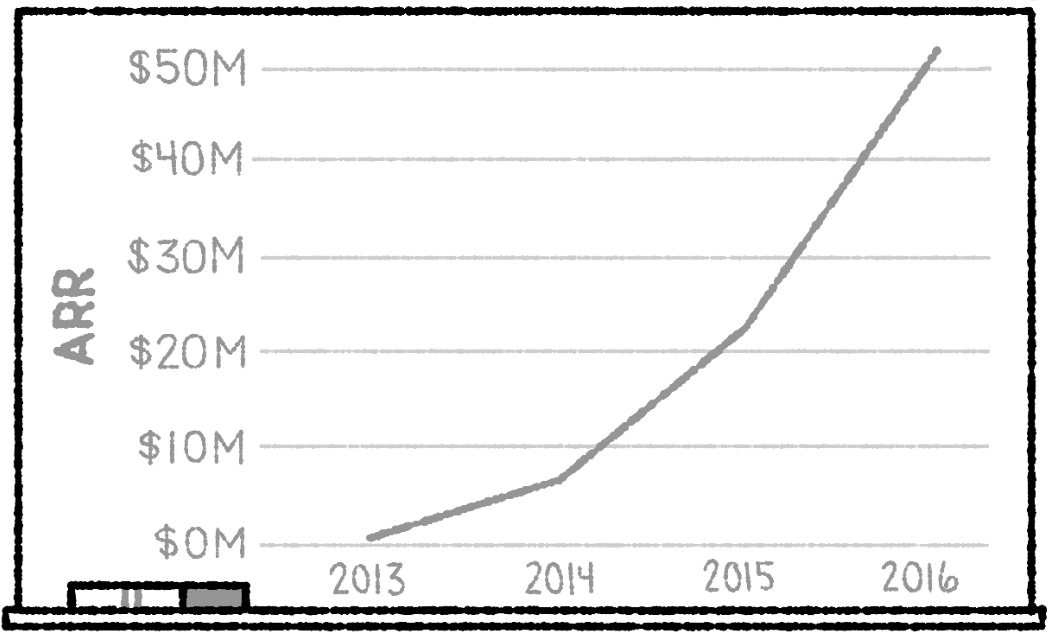
To put Intercom’s success into even crazier perspective, the only SaaS in history to grow faster is Slack.
Best of all, Intercom has grown — and continues to grow — WITHOUT spending insane amounts of money on advertising or marketing.
This means you can do it for your business, too.
Here’s how Intercom gets most of their web traffic:

With an amazing blog, a select group of targeted paid keywords, and an advanced referral traffic strategy, it makes sense they have a very high amount of direct traffic.
Beyond direct traffic, Intercom gets the most traffic from search and referral.
To increase your own direct, search, and referral traffic, here are 10 growth marketing ideas you can apply in your business.
Table of Contents
%(tableofcontents)
[Tip #1] The Biggest Viral Marketing Hack You’ve Never Seen: “Powered By” Plus Dynamic Keyword Insertion
Here’s a look at Intercom’s top referring sites.
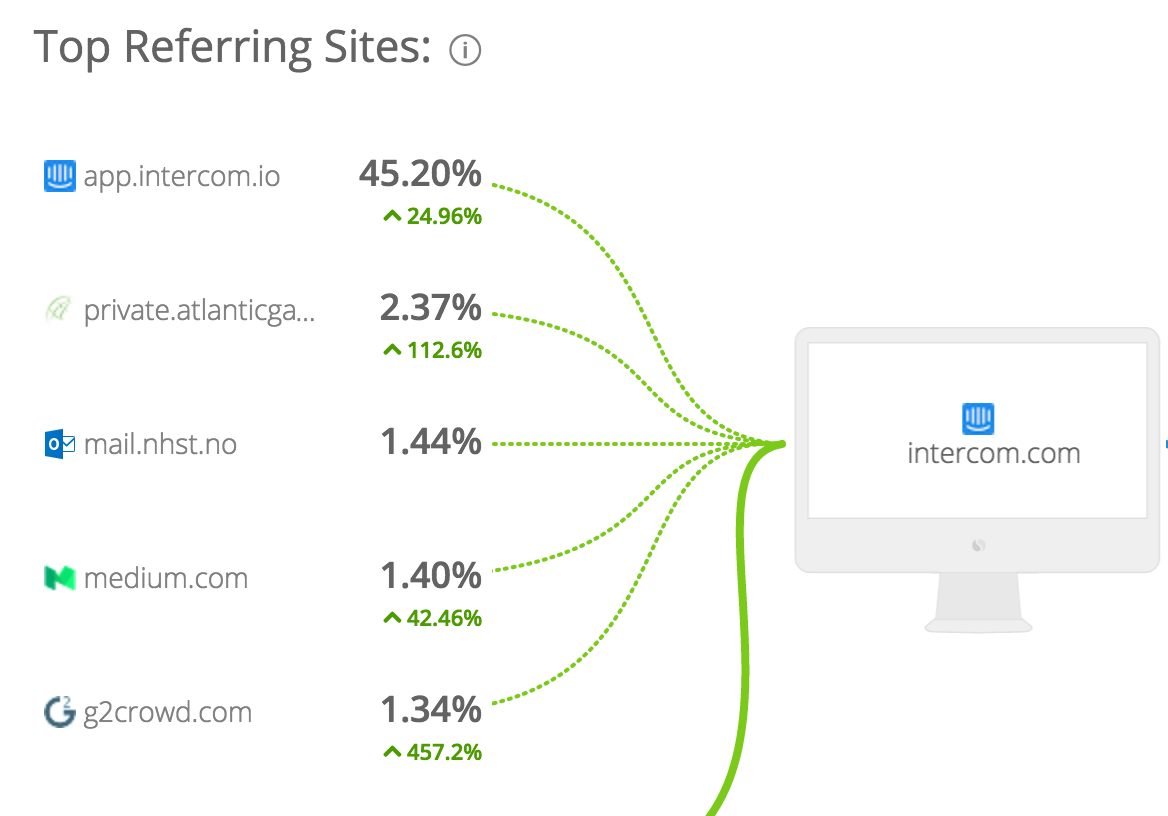
The number one referrer is from the Intercom app itself – most likely coming from the free trial or paying customers logged in to the app.
The other referrers are where it gets more interesting because of Intercom’s incredible “powered by” tactic. Let’s look at the 2nd referrer as an example.
First, we head to the Atlantic Global Asset Management page. Notice the personalized live chat box in the bottom right corner.
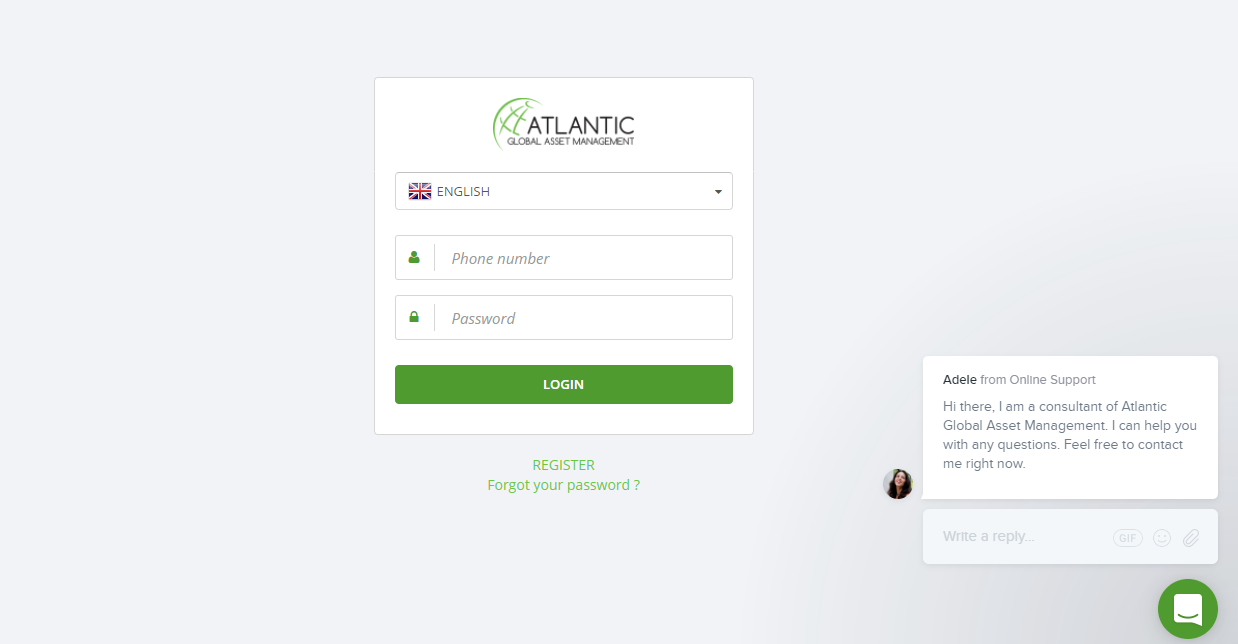
If I click the chat box, I’ll find an unobtrusive little message stating “We run on Intercom.”
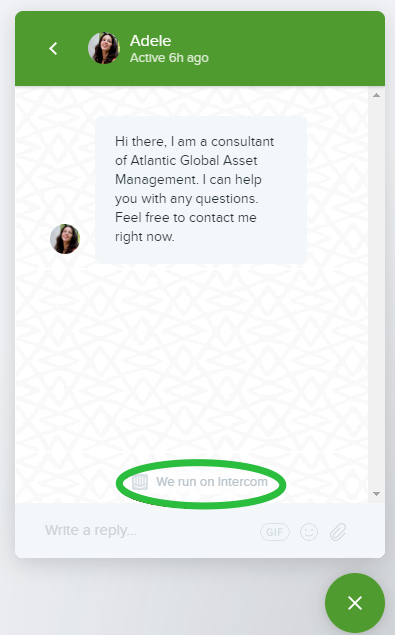
If I’m curious and want to learn more, I can click and I’ll be taken to a dedicated landing page Intercom has set up for people who come from the Atlantic Global Asset Management website.
This is what the landing page looks like (pay close attention to the headline):
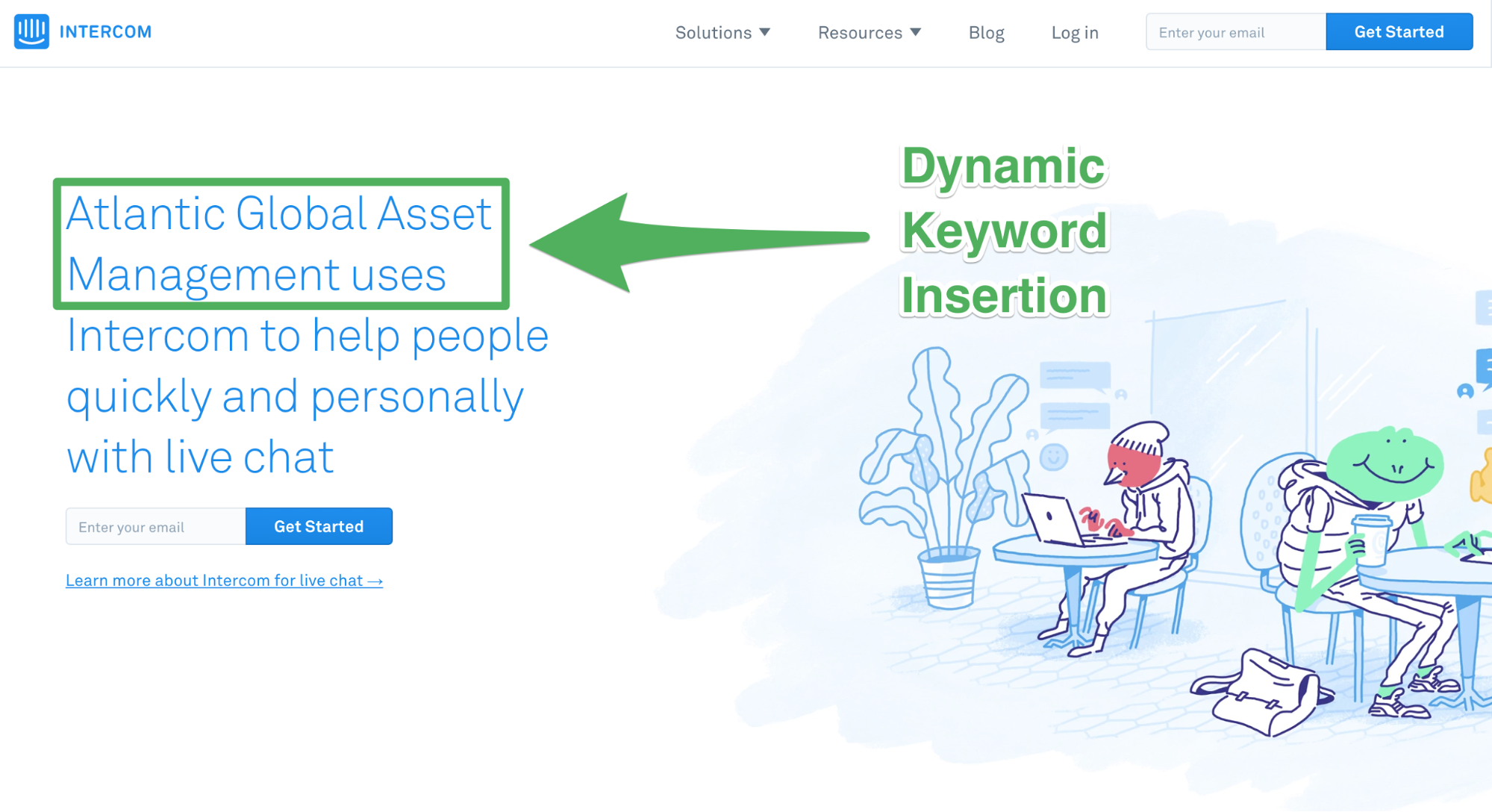
Golden Nugget: If you are just asking for an email address on your landing page like Intercom, you can use a lead enrichment tool to give your sales team more data on name, company, title, number of employees, etc so you can determine if the lead is qualified for your sales development team.
Click here to reveal the lead enrichment tool Intercom uses.
The team at Intercom uses dynamic keyword insertion from the company that prospects just came from in the landing page headline to personalize the landing page experience for visitors based on the referring company.
They set this up by using a custom URL parameter. Here’s what the custom URL for the Atlantic Global Asset Management landing page looks like:
https://www.intercom.com/intercom-link?company=Atlantic%20Global%20Asset%20Management
&solution=live-chat
You’ll notice Intercom is using a “company” parameter in their referral URL.
Intercom combines the “powered by” tactic with dynamic keyword insertion in the headline to increase conversions from their referral traffic.
Instinctually, people are more likely to trust a new product if they get a recommendation from a company they are already familiar with.
Knowing this, Intercom made sure customers understood the connection they already had with Atlantic Global Asset Management as a way to increase customer confidence in their product and convert more visitors.
The takeaway: Identify marketing channels that are already working for you right now and look for ways to growth hack them to a whole new level (Intercom did this by growth hacking their “powered by” landing pages with dynamic keyword insertion in the headline using a custom URL parameter).
[Tip #2] Competitor Traffic Strategy: Steal Your Competitors’ Traffic With “Alternative” Landing Pages
There is a website traffic loophole you can use to steal your competitors customers and traffic. Here's how Intercom is using it:
Drift (one of Intercom’s competitors) is on Intercom’s list of top 5 paid keywords.
Intercom has done enough research to know the type of people searching for Drift have certain needs. And Intercom can “intercept” those searchers and appeal directly to those needs to turn these people into customers.
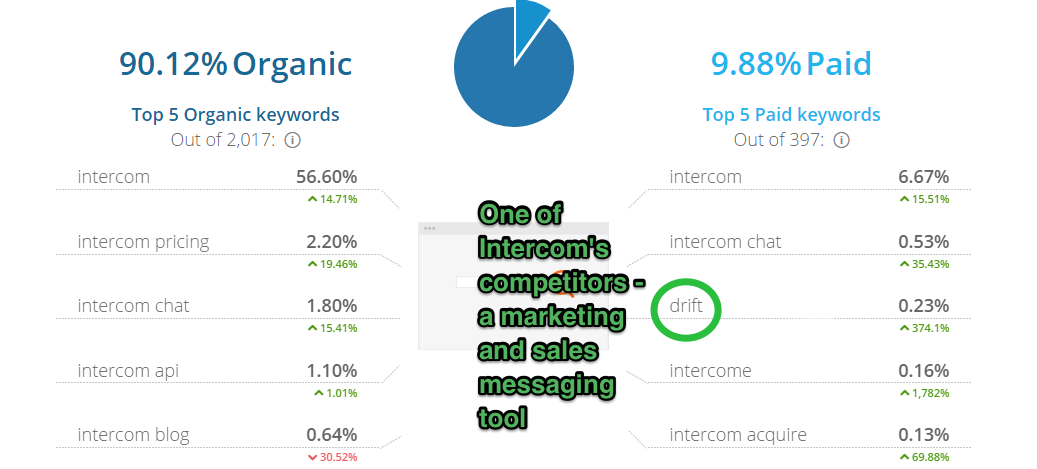
Here’s the paid ad Intercom uses to direct Drift branded traffic back to their website:

And they don’t just stop at Drift. They go after other major competitors traffic as well, like Olark:

Specifically, Intercom sends people to their Live Chat landing page for Drift branded keyword traffic.
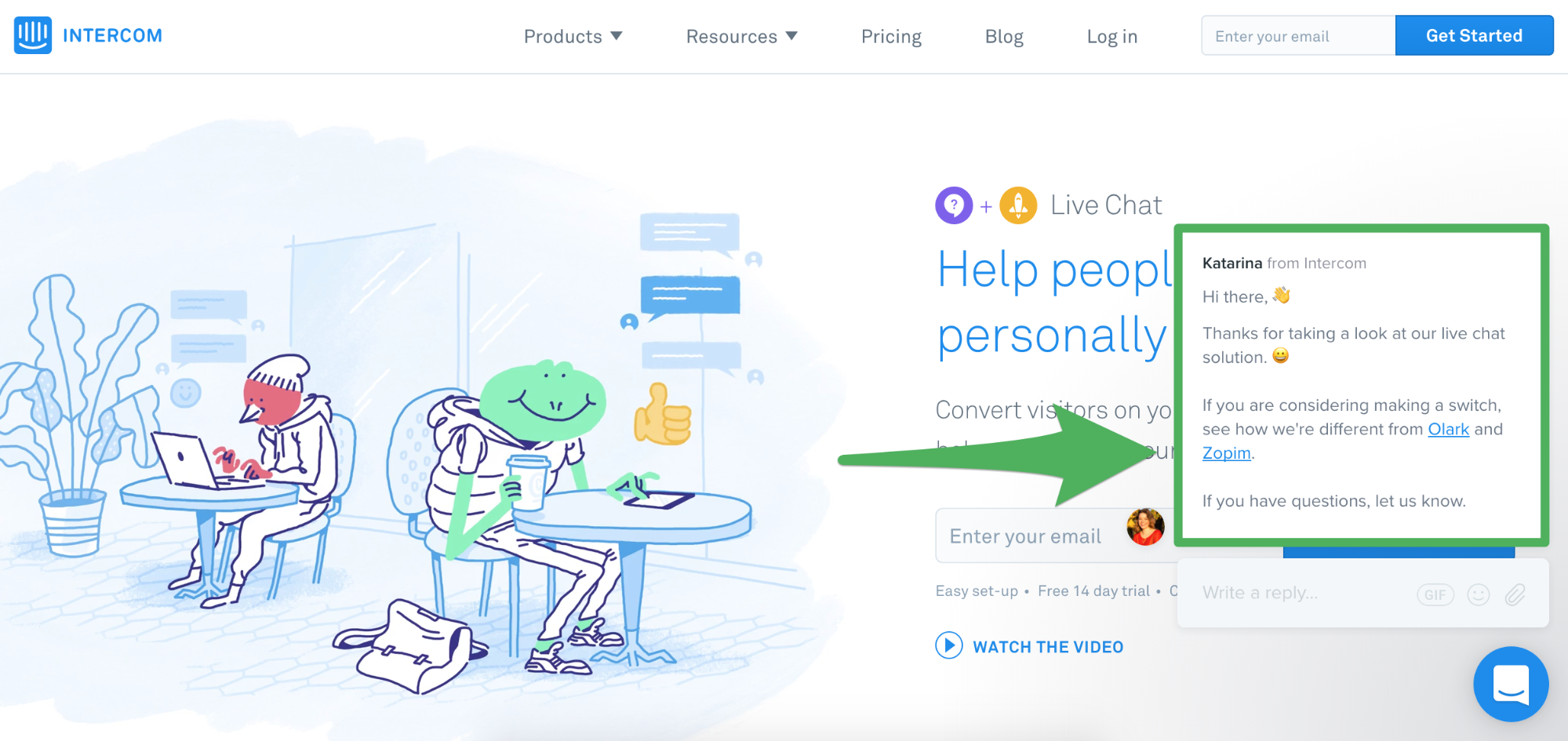
Golden Nugget: Take note of how Intercom uses their own Live Chat feature to call-out 2 of their biggest competitors. They then link to “Olark Alternative” and “Zopim Alternative” landing pages to convince people to make the switch the Intercom.
Here is what the Olark Alternative landing page looks like (Intercom link to this page directly in their Olark paid search ad):[*]
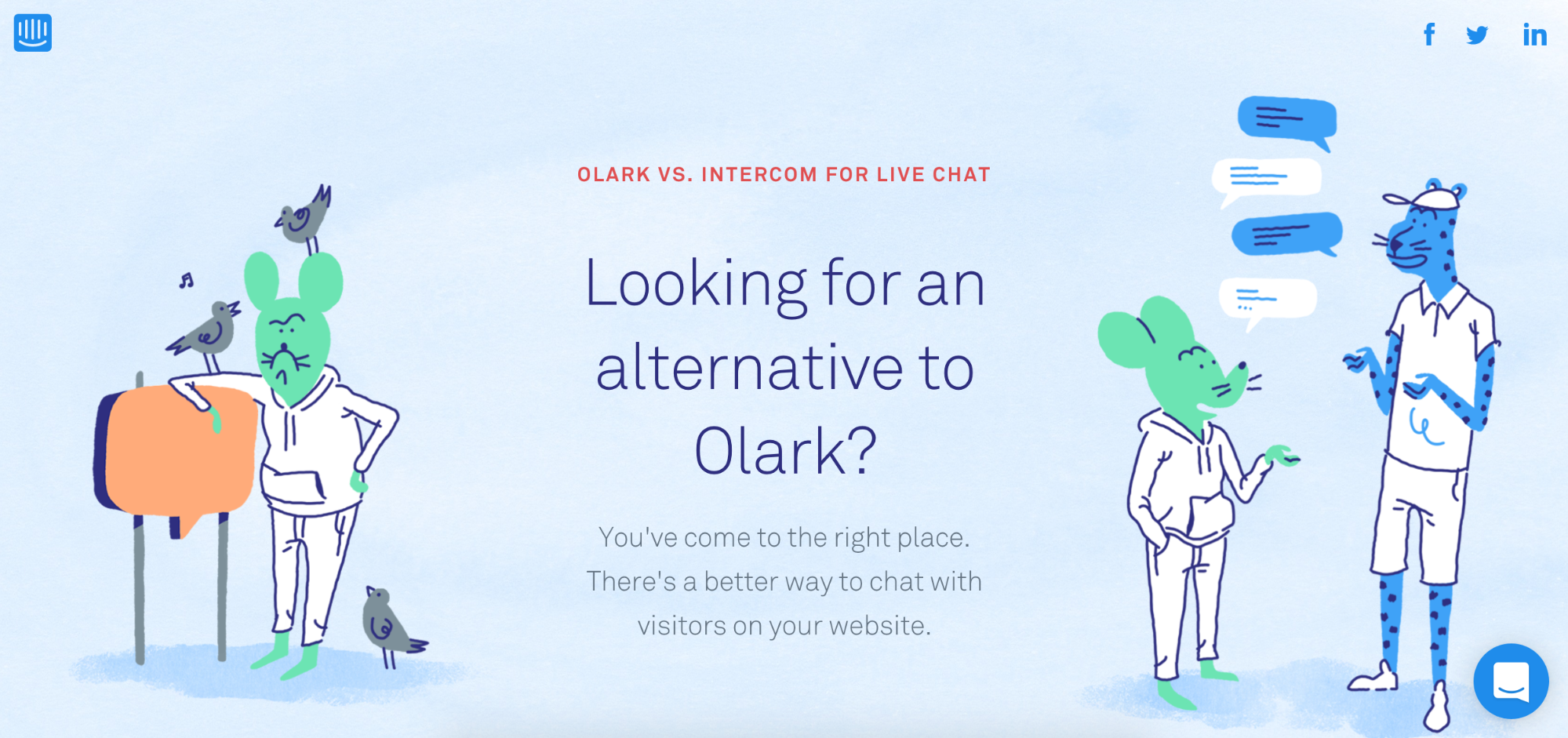
They dig deep into the key pain points of using Olark over Intercom and show why Intercom are better by using screenshots of the products side-by-side with social proof showing why big companies choose Intercom.
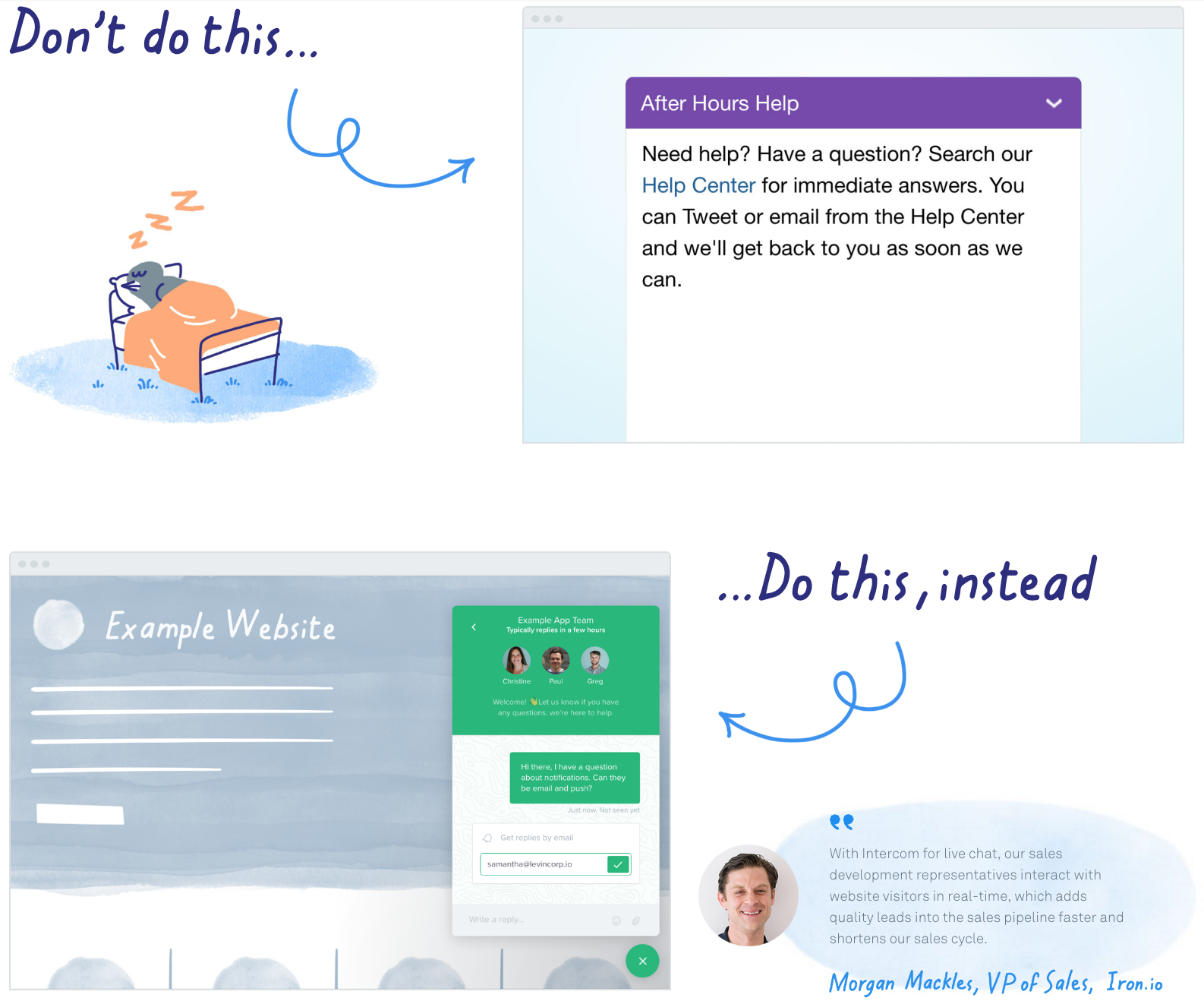
But Intercom’s competition isn’t just standing by and watching. When you look at Drift’s top paid keywords, you can see that three of them are Intercom-based:

They’re following a similar strategy to try and get people to switch from Intercom to Drift — but they’re taking it to a whole new level with their “Intercom Alternative” landing page and chat widget combination.[*]
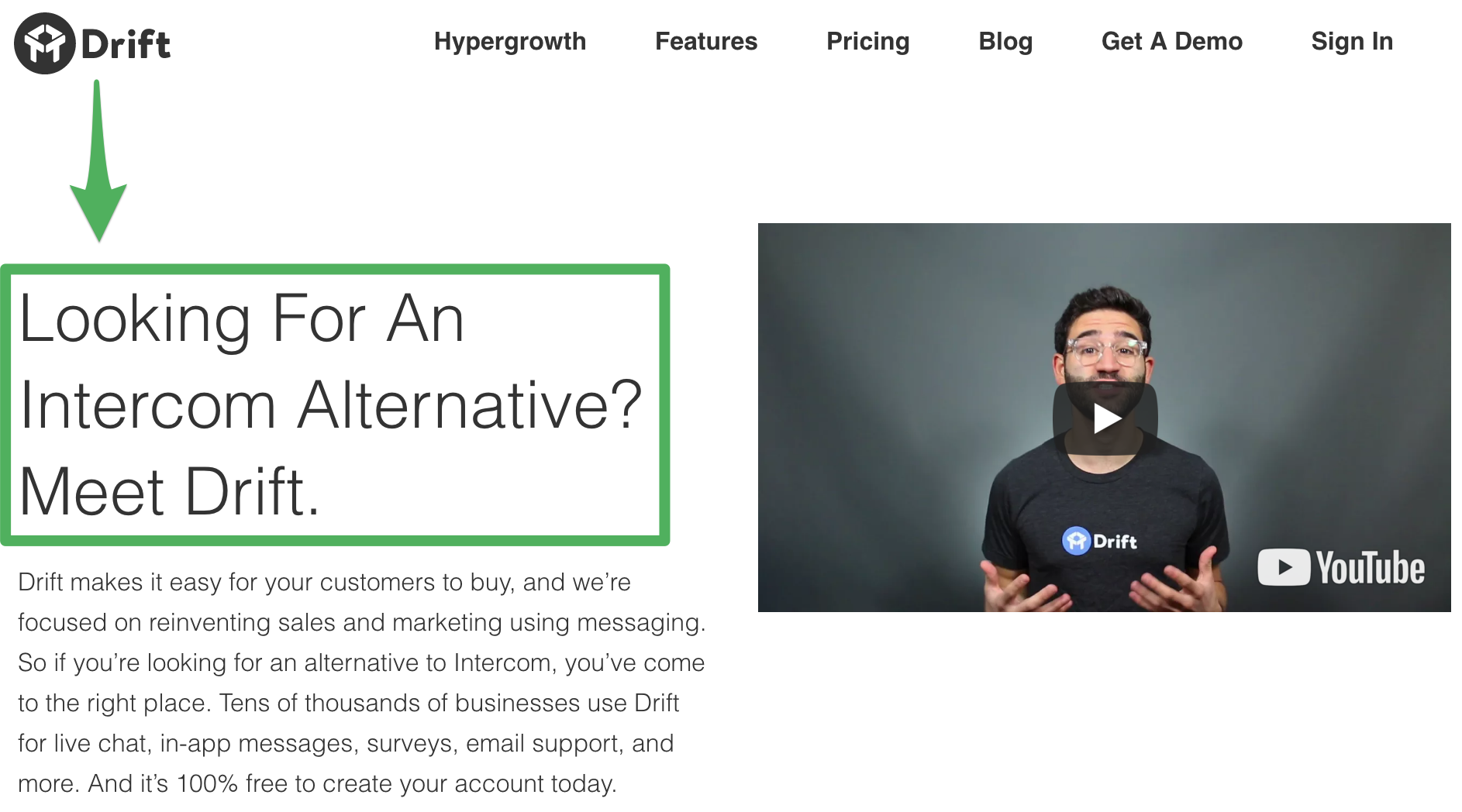
The Drift team is using this personalized landing page to try and convert Intercom customers into Drift customers.
Below is an example of one section on this landing page:
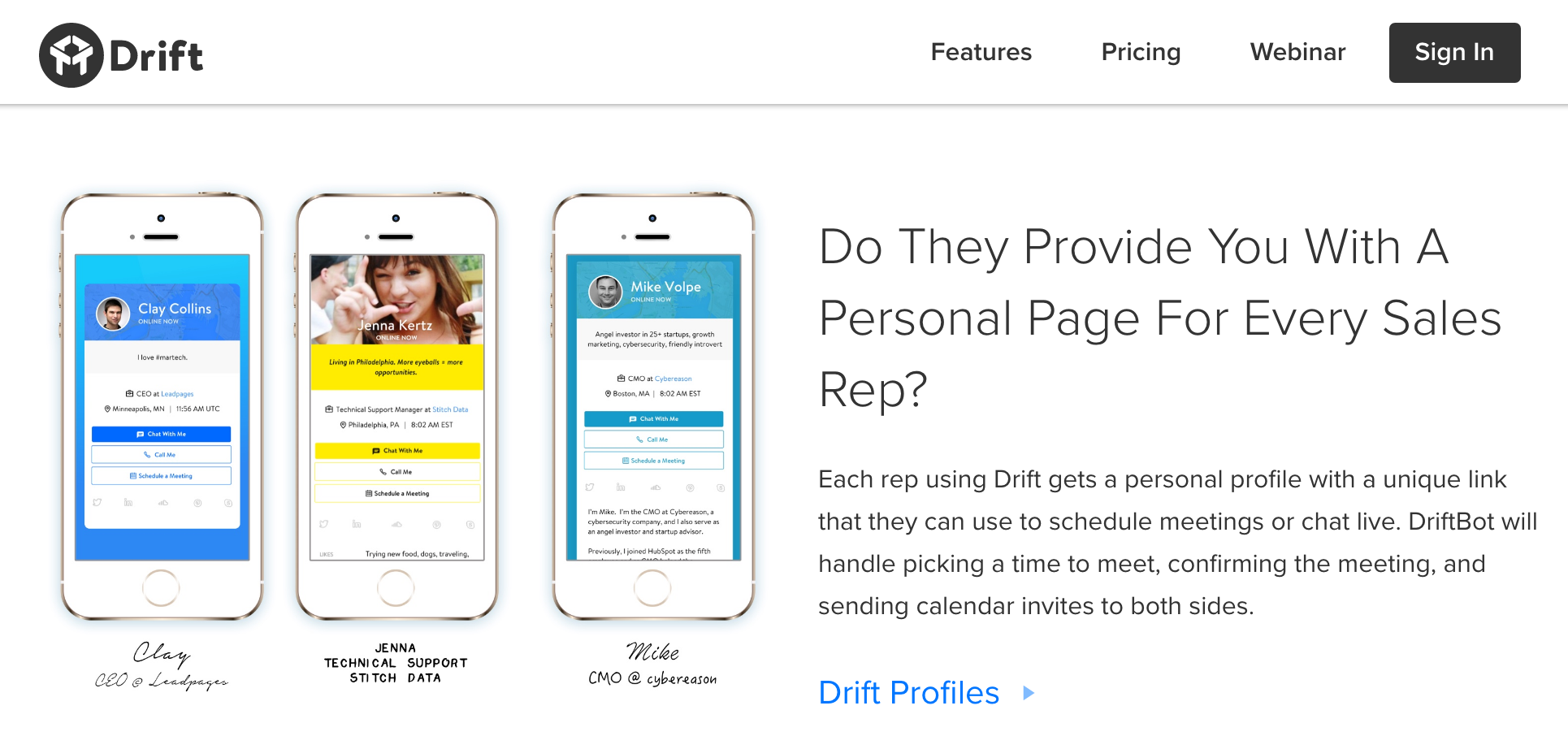
Golden Nugget: Take note of how Drift uses question-based copy to tie into each of their unique selling points to try and convince people to switch from Intercom to Drift. It’s a super-compelling way to differentiate their product from their bigshot competitor.
Creating a landing page like this yourself will make you do some serious digging into what really makes your company and product stand out from your competition (which is something you should probably being doing anyway).
They even use their chat widget to link to a case study (during the first time you visit the page) on their blog about why 15Five switched from Intercom to Drift. Here’s what it looks like:
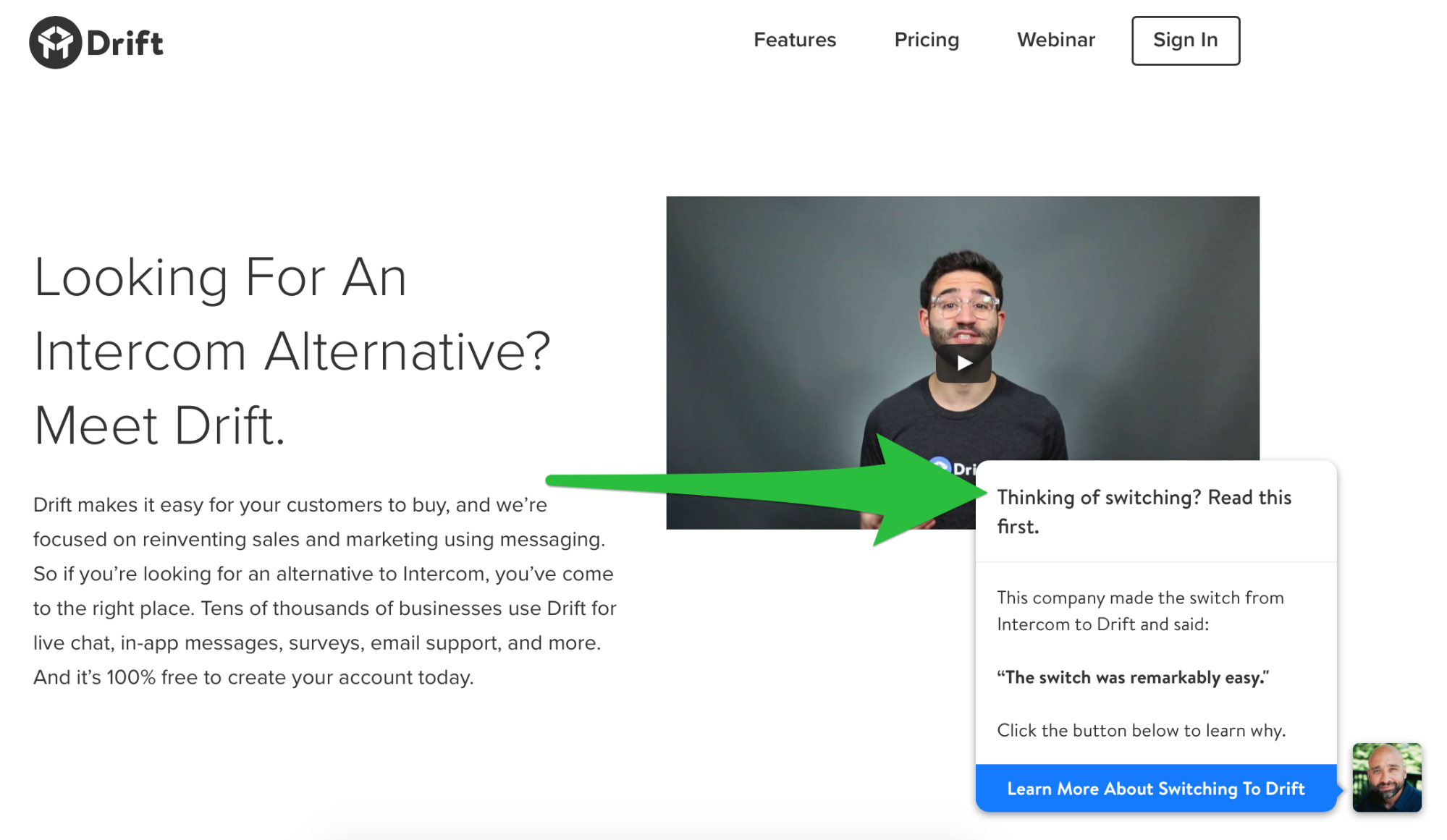
If you’re trying to compete against a major competitor, this is your David vs. Goliath opportunity to take them down using highly relevant, targeted marketing.
Bidding on competitors’ keywords isn’t cheap, especially when your competitors are bidding on their own branded keywords (like Intercom).
But if you put together a landing page for those keywords with a convincing USP that can solve your customers’ problems better than your competitors can, the payoff may just be worth it (which I bet it is for Intercom and Drift).
The takeaway: Be aware of big competitors that have a product offering that’s similar to your own, and work to counter it by showing customers what makes your product better (Intercom do it by creating a customized “Olark Alternative” landing page for PPC traffic to steal traffic and customers from Olark. It’s also a tactic Drift uses to get traffic from Intercom branded keywords, by sending Intercom branded keyword traffic to a dedicated “Intercom Alternative” landing page).
[Tip #3] Simple SEO Growth Strategy: Focus on Google Keywords That Will Bring You The Highest Number of Qualified Leads Using “The Core Problem Framework”
409 of Intercom’s 29,230 keywords on Google rank as first page results.
To give you some perspective, only 8% of HubSpot’s keywords rank on the first page of Google, compared to Intercom’s 18%.
While the raw number of total organic keywords (409) may be on the low side, every keyword that ranks on the first page has one common theme:
The keyword’s related content solves one core problem.
This has allowed Intercom to achieve 2 specific goals:
- Build a trusted brand authority website
- Focus on Google keywords that will bring them the highest number of qualified leads
It’s a clever little strategy that follows what I like to call “The Core Problem Framework.”
Basically, it’s about writing articles on topics based on core problems your customer persona faces (instead of just writing articles to rank for a keyword).
To see what a mean, here’s a summary of some of Intercom’s top organic keywords, ranked by keywords on the first page of Google with the highest average global monthly search volume:
| Keyword | Global Monthly Search Volume |
Organic Listing | Rank |
| intercom | 165,000 | Intercom Home Page[*] | 1 |
| product manager | 33,100 | Q&A: What does a product manager do?[*] | 8 |
| customer feedback | 5,400 | Making sense of customer feedback[*] | 10 |
| jobs to be done | 5,400 | Designing features using Job Stories[*] | 10 |
| pricing models | 4,400 | Picking a pricing strategy for your product[*] | 3 |
| user onboarding | 1,900 | Strategies for onboarding new users[*] | 9 |
| website chat | 1,600 | Intercom “Live Chat” Product Page[*] | 8 |
| user engagement | 1,000 | Ways to increase customer engagement[*] | 1 |
| customer service metrics | 590 | The 5 customer support metrics that matter[*] | 6 |
Intercom didn’t get these rankings by keyword-stuffing articles.
They got them by writing articles solving real problems their target customers face every day (customer feedback, user onboarding, pricing models, user engagement, etc.).
It’s what SEO experts call “Semantic SEO.”
In other words, creating articles that answers a question or search phrase so even when the article doesn't contain an exact match of the keyword, Google’s search algorithm is smart enough to interpret a searcher’s intent and show it to the user.
The takeaway: With artificial intelligence in search evolving beyond keywords, using the “The Core Problem Framework” is a great long-term white hat SEO strategy that is proven to work (Intercom do it by writing one piece of content to solve one core problem their customers have in their day-to-day job).
[Tip #4] New, Brand-Building Content Strategy: Write Original, Thought-Provoking Branded Content To Get THOUSANDS of Shares Using “The Proven Topic Framework”
You may think that all of Intercom’s organic traffic just comes from their high ranking Google keywords in the last section, but that is not the case. Those “Semantic SEO” optimized articles are just one part of Intercom’s overall brand-building content strategy.
Intercom’s content strategy also includes original, thought-provoking branded content pieces that get thousands of shares…even though you won’t find them ranking anywhere on the 1st page of Google.
These original, branded content pieces are at the core of Intercom’s marketing and customer acquisition strategy.
Here is what Des Traynor (co-founder of Intercom) said on September 9, 2011 on Hacker News, in response to the question “Ask HN: How do you promote your web apps?”[*]

Intercom’s content team has been blogging for close to 6 years to build their branded content, starting when Des Traynor posted their first article “Recent new features in Intercom” on October 6, 2011 (98 days after Intercom launched).[*]
The branded content on their blog has helped the product rapidly grow, so it’s worth taking a look at what they are doing to get so much engagement.
Luckily, an article on Intercom’s blog titled “How do you decide what to write?” by Intercom managing editor John Collins outlines 5 tactics Intercom uses to create highly-shareable articles:[*]
- Recycle content
- Expose your data
- Share your work
- Move the conversation on
- Read widely
Here are Intercom’s top blog posts based on social engagement:
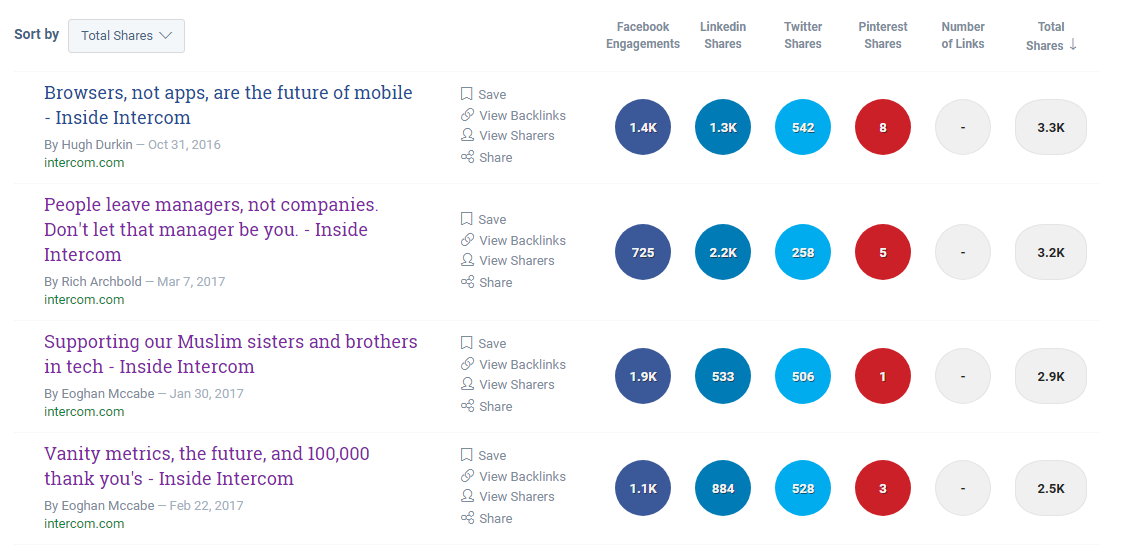
These top articles are based on one of the 5 tactics outlined above, so let’s breakdown how each of these individual posts have become so popular…
-
Browser, not apps, are the future of mobile[*]
-
People leave managers, not companies[*]
-
Supporting our Muslim sisters and brothers in tech[*]
-
Vanity metrics, the future, and 100,000 “thank yous”[*]
This is Intercom’s most popular article. It draws inspiration from a 2014 article with 4,700 shares on Quartz titled “Most smartphone users download zero apps per month.”
By drawing inspiration from that widely-shared article and adding to the discussion, Intercom’s own article went viral on Hacker News with 185 comments:

Coming up with content topics like this comes from John’s tactic #5: reading widely. Reading widely in areas beyond “your world” will give ideas and inspiration for unique content that you might have missed otherwise.
This is Intercom’s second most popular article. It was published on March 7, 2017. But interestingly enough, there was a post on exactly the same topic that went viral and made it to #1 on Hacker News over 4 years ago on February 7th, 2013:

As with the article above, Intercom leveraged the popularity of this #1 Hacker News post from over 4 years ago, using it to draw inspiration and add to the debate.[*]
Instead of leading with a story like the old Hacker News #1 article did, Intercom lead with data-backed evidence from a recent study to “move the conversation on.”
This smart “Move the conversation on” content tactic is tip #4 above. In other words, research the most shared content in the history of your industry, and write something that tosses your hat (and ideas) into the ring.
But as John puts it, “don’t waste your potential customers’ time by simply rehashing old arguments. Remember the idea is to produce something evergreen that has value for longer than a week.”
Intercom’s third most popular article is a direct response offer to help Muslims in the tech community relocate to Dublin (providing free relocation advice, a job opportunity in a Dublin tech company, legal bills up to €5k and an Intercom buddy program to explore Dublin).
This article doesn’t exactly fit into one of the 5 tactics above, but it does fit into a 6th content tactic that I often see Intecom doing: Don’t hide your company’s voice and vision just because it’s a little controversial.
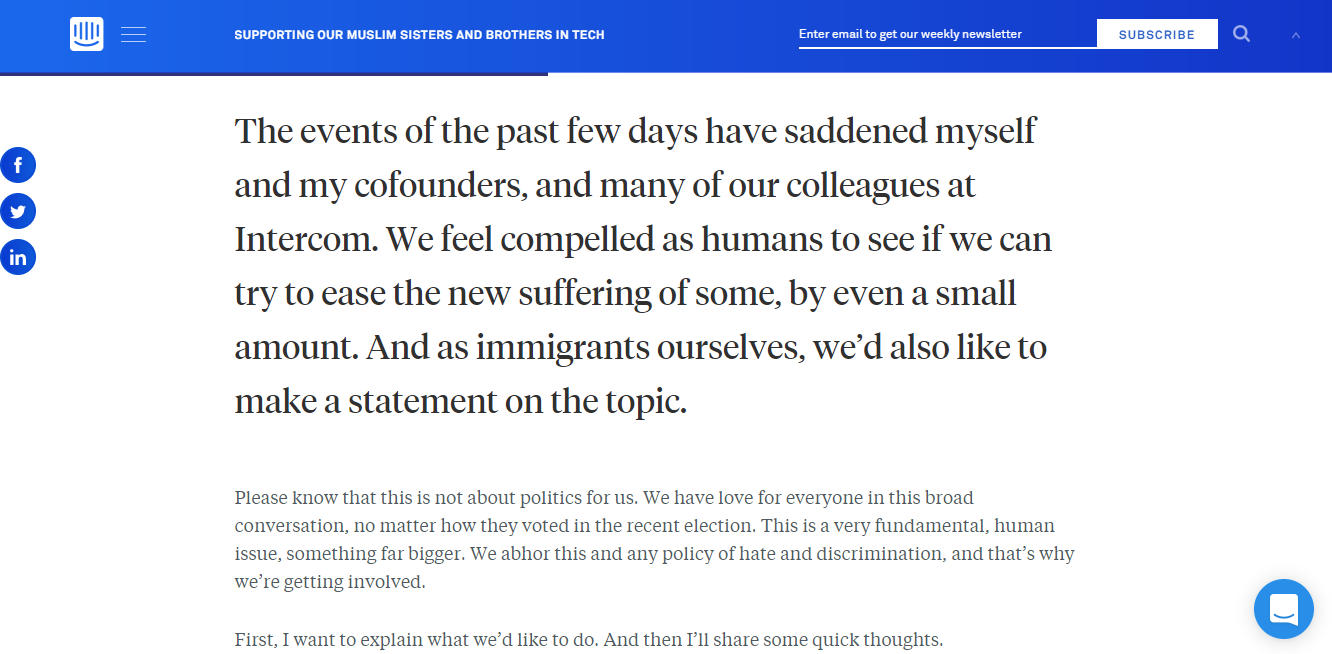
The article above is a personal and heartfelt blog post from Intercom co-founder Eoghan McCabe.
Eoghan and Intercom don’t shy away from controversy if there’s something they truly believe in.
This article was so widely shared because of the amazing offer Intercom made giving back, and expecting nothing in return. And as you can see, it also perfectly aligns with Intercom’s original vision, marketing strategy, and current solutions that are all based on one emphasis: Real, human connection.
Intercom’s fourth most popular article became so popular because it was their first public update from co-founder Eoghan McCabe on Intercom’s growth since their last 4 rounds of funding 13 months ago.

In the post, Eoghan reveals Intercom’s number of monthly active users, in-app conversations, revenue growth for the past 5 years, profitability and plans for future growth.
This “Expose your data” article is content tactic #2. People love a good success story (especially one backed by hard data – a bit like this growth study is)… so if you’ve got it, flaunt it 😉
The takeaway: There are many different ways to make your content go viral. Pick a content marketing idea from the 5 tactics in Intercom’s “Proven Topic Framework” and write your own original, thought-provoking piece of branded content.
P.S: Still stuck on what to write? Then check out our Sumo-sized data study analyzing the highest trafficked content based on 175,000,000 visitors to find out what type of blog posts get noticed.
[Tip #5] The Most Unusual Method For Converting Content Into New Product Signups: “The Next Step CTA Method”
There are 2 elements that are uniform across all of Intercom’s blog posts:
-
An author caricature. Keeping in-line with Intercom’s emphasis on real, human connection, you’ll find a small caricature of the author at the top of each and every post.
-
A big, bold statement at the top of the page. All of Intercom’s blog posts begin with big, bold statements that capture the reader’s attention and gives them a hint as to what they’ll find if they keep reading.
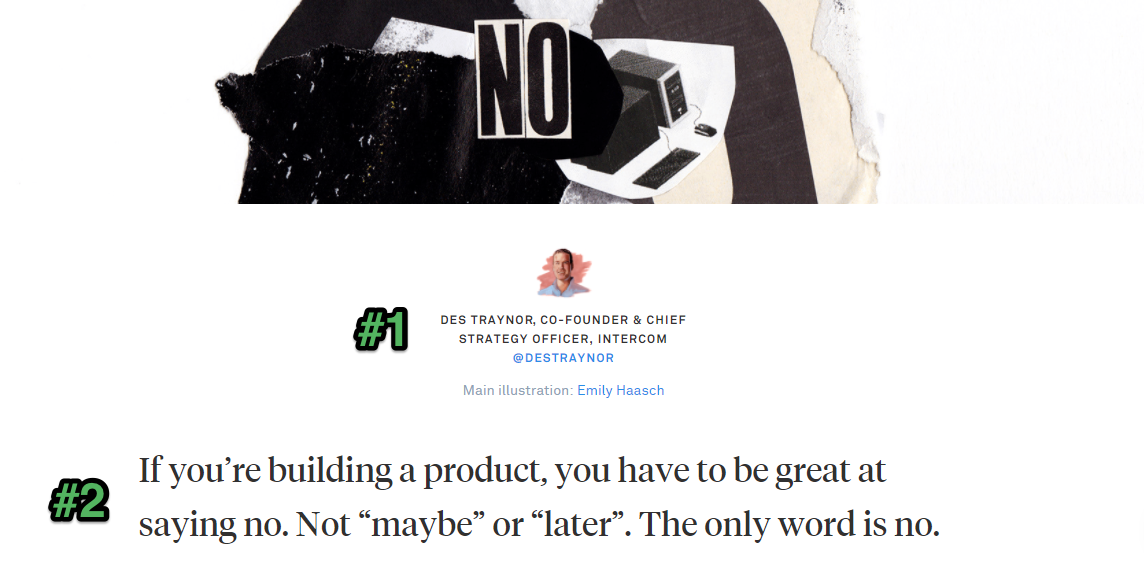
But arguably, one of the most interesting and unique aspects of Intercom’s blog posts is that the final calls-to-action are very irregular.
At the end of a blog post for your average website, you can almost guarantee you’ll be bombarded with an annoying, brightly colored email sign-up box or sales push.
That’s not the case with Intercom.
While some of Intercom’s articles do offer the expected lead magnet, the others vary quite a bit. See below:
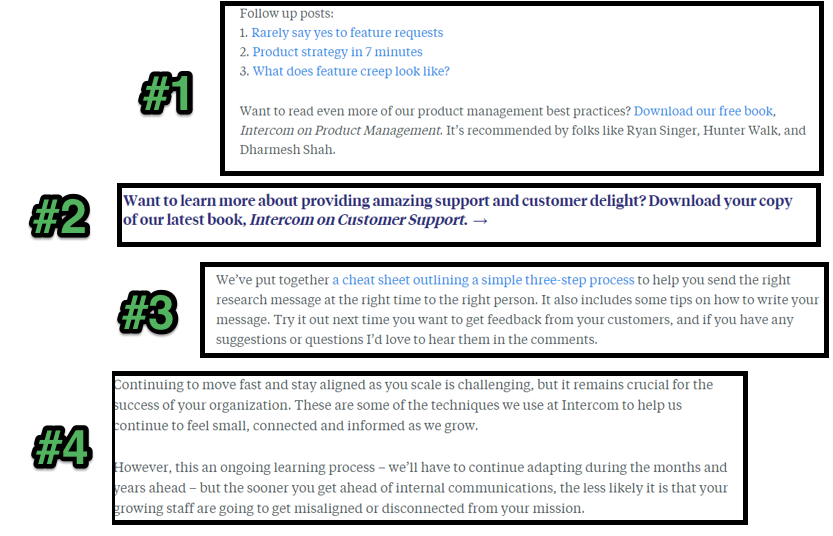
Here’s a quick breakdown of the CTAs from the image above:
- CTA 1: Free book download (Intercom on Product Management) in exchange for giving your email address[*]
- CTA 2: Free book download (Intercom on Customer Support) in exchange for giving your email address[*]
- CTA 3: Downloadable “cheat sheet” (Research Message Cheat Sheet) that readers can download without giving any contact info. This is an unusual tactic as it gives Intercom no way to continue nurturing these leads in the future.[*]
- CTA 4: A post conspicuously absent of any type of call-to-action at all
Occasionally, I came across a CTA asking readers to join the free newsletter.

Of all the CTAs I saw on Intercom’s blog, the ones broadcasting the newsletter were the biggest and boldest (though compared to what you usually find on other websites, it really was neither big nor bold).
Even the weekly newsletter itself lacks any sort of the usual CTAs you would expect to see.
The lack of CTAs is likely a reflection of Intercom’s vision. As opposed to focusing on keyword-stuffed, lead generation obsessed articles, many articles operate from a foundation of strong, personal, genuine communication (just like we saw with our 5 “what to write” tactics above).
In some ways, perhaps creating articles without strong CTAs, annoying pop-ups, or aggressive “marketing speak” is one of Intercom’s ways of showing its customers that it hasn’t given up on its original vision of authentic connection.
In other words, this could be a beneficial way to strengthen customer trust and improve perception of the company as a whole.
The takeaway: Think about what the most logical next step is for someone to take after reading your content piece and use that as your CTA. Maybe it’s to leave off the CTA entirely like Intercom sometimes does….or is it to download your book, download a cheat sheet, sign-up for your newsletter or something else?
[Tip #6] Follow Intercom’s Simple Offsite Content Strategy To Get All Your Content Seen By A New Audience
To increase the traffic, reach and engagement for each of their blog posts, Intercom set up a Medium publication called Inside Intercom.[*]
The “Inside Intercom” branding matches the branding of their blog.[*]
They launched their Medium publication on July 3, 2014 and use Medium as a platform to re-post their articles from their blog.
Interestingly, Intercom doesn’t just re-post to their Medium publication right after a blog post is published. They wait 2-11 months before re-posting their original piece of content from the blog.
Here are the top 5 Medium posts (based on Medium recommends) with their publish dates on the Inside Intercom blog vs. Inside Intercom Medium publication:
| Article | Medium Claps | Blog Publish Date |
Medium Publish Date |
| The dribbblisation of design | 4.8k | 2013-09-18 | 2014-08-18 |
| Why mobile first is outdated | 1.3k | 2015-05-13 | 2016-01-29 |
| The end of app stores as we know them | 985 | 2016-01-27 | 2016-04-15 |
| Messaging is just getting started | 896 | 2015-05-27 | 2015-04-03 |
| Has visual design fallen flat? | 730 | 2015-01-19 | 2015-04-03 |
As you might have noticed, their most recommended articles on Medium are not the same as their most shared blog posts on their main website’s blog.
I found the exact same findings when I researched HubSpot’s Medium strategy.[*]
HubSpot found that their “optimized for search” blog content wasn’t generating many views on Medium. Instead they found “optimizing for people” with opinion pieces, personal accounts and reaction posts had the best performance on Medium.
Just like in the blog post CTA tip above, Intercom matches their Medium CTAs to the logical next steps. But in this case, they usually give people several CTA options to further engage with their brand.
The most common Intercom Medium articles have four different CTA links:
CTA #1: Author’s Twitter profile
CTA #2: Intercom blog (and a note saying that this Medium article first appeared on said blog)
CTA #3: Intercom product page for a specific, relevant product (based on the article’s topic)
CTA #4: 3 other relevant articles on Intercom’s blog
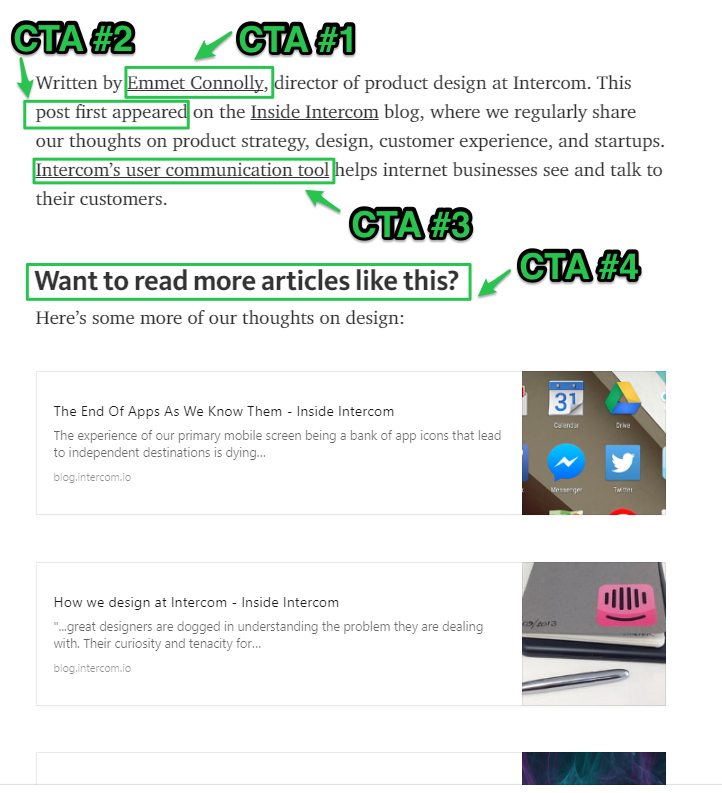
You may be wondering if reposting your blog content on Medium will cause duplicate content issues for your SEO. Usually, putting the same content in two places (like Intercom’s blog and then again on their Medium publication) is thought to be a big SEO no-no.
But Medium actually has an “Import” feature which allows you to import a blog post from your blog and it will attribute the canonical URL (the “preferred” version of a web page you want to rank for SEO) back to your original post.

You just need to indicate that you want your blog post on your website to be the preferred URL with the rel="canonical" link element in the header section of your page.
Here is what that code looks like on this article you're reading right now:
<link rel="canonical" href=" https://bdow.com/stories/intercom-marketing" />
Then, you make sure wherever you re-post the piece of content that there is a link back to the original article.
Here is what Hugh “Taco” Durkin (Senior Product Manager at Intercom and the guy who wrote Intercom’s most shared article of all-time) had to say after he saw the first version of this article:
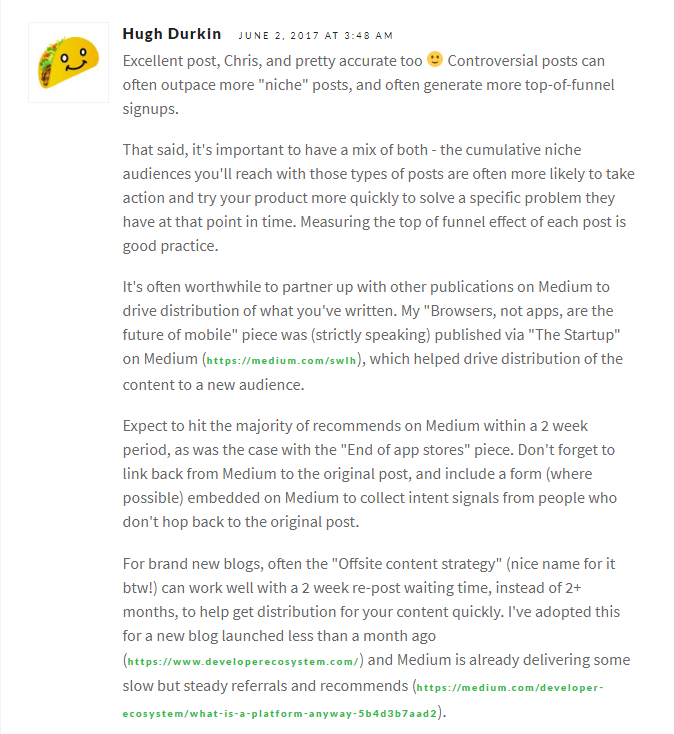
The tl;dr version of Hugh’s comment:
- It’s important to have a mix of “controversial” posts (which can give you a lot of momentum and generate top-of-funnel sign ups) as well as more specific “niche” posts (which are more likely to get people to take action and try your product)
- You can partner up with other Medium publications to distribute what you’ve written even more
- You’ll probably hit the majority of your Medium recommends within 2 weeks of publishing
- Link back from Medium to the original post
- For brand new blogs, re-posting your articles on Medium after 2 weeks can do well
Thanks for stopping by, Hugh!
Just one last thing to keep in mind. What works well with one platform (like your blog), might not perform as well on another platform (like Medium, LinkedIn, social media, etc).
In Intercom’s case, they found that articles with unique and controversial viewpoints generally perform better on the Medium platform (as you can see from Intercom’s blog vs Medium data).
The takeaway: Look for other media platforms where your target audience hang out and re-purpose your content for that platform. Intercom do it with their blog content on Medium.
Tip #10 on my Tony Robbins Sumo Growth Study will give you a few more ideas on how you can re-purpose your content.
[Tip #7] Ultra-Granular Paid Search Strategy: Focus On High Buy Intent Keywords If You Want To Be Successful Without A Big Ad Budget
Of the 2,000 PPC keywords Intercom is bidding on, here are its top 5 highest performing ads:
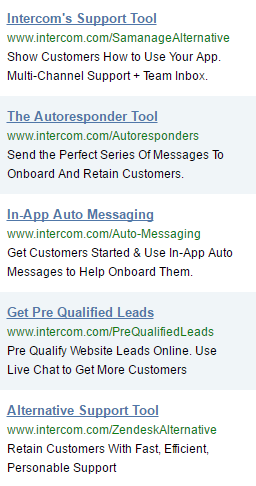
The ads vary by directing visitors to different landing pages depending on a search term. The variance in ads allows each of Intercom’s solutions to get exposure.
Here’s the entire paid search funnel for the second ad “The Autoresponder Tool”:

This is how it breaks down:
- One keyword (autoresponder keyword)
- One ad relevant to that keyword (autoresponder ad)
- One landing page relevant to that ad (customer engagement solution landing page that talks about Intercom’s autoresponder functionality)
After scrolling past the top performers, the focus seems to be on paid ads targeting the live-chat tool – most likely because this is a search term that has proven to do extra well.
On that note, here is a table of Intercom’s 4 main active paid search funnels along with the 4 landing pages they drive traffic to:
| Type of Keyword | Type of PPC Ad | Landing Page |
| Unbranded Customer Engagement Keywords | Customer Engagement Ad | Onboarding & Retention Solution Free Trial Offer[*] |
| Unbranded Live Chat Keywords | Live Chat Ad | Live Chat Solution Free Trial Offer[*] |
| Unbranded Customer Support Keywords | Customer Support Ad | Customer Support Solution Free Trial Offer[*] |
| Unbranded Alternative Keywords | “X Alternative” Tool Ad | “Olark Alternative” Free Trial Offer[*] |
The majority of Intercom’s PPC keywords were first seen at the end of 2016.
This suggests it’s only recently Intercom has been ramping up its paid marketing strategy (probably because their content and word-of-mouth marketing has been so effective).
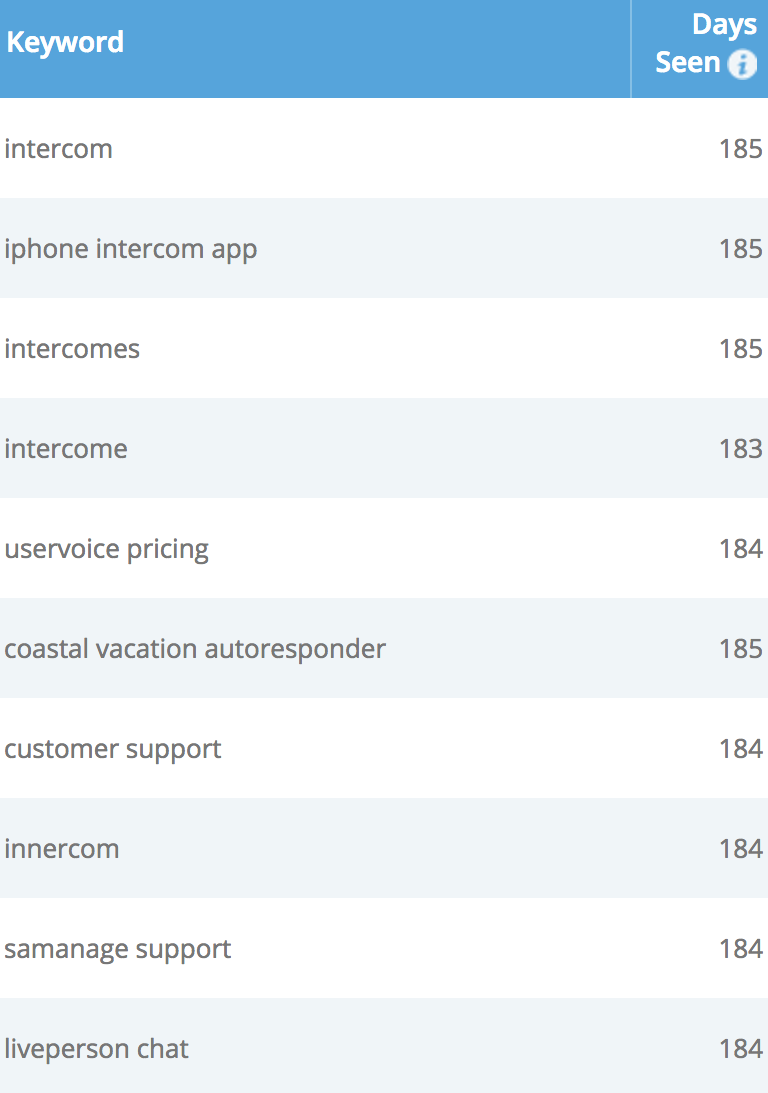
It also looks like Intercom is investing in retargeting ads. Recently, this ad popped up on my Facebook News Feed:

To really grab the attention of casual Facebook browsers, the ad double-mentions the free trial — Something the Google ads above don’t.
The takeaway: PPC traffic works best when you go ultra-granular with 1 Keyword > 1 Ad > 1 Landing Page. It’s a strategy I see more and more SaaS companies like Intercom using to increase qualified leads as they dial in their PPC campaigns.
[Tip #8] Advanced Landing Page Strategy: Convert Your Traffic Into Customers By Matching Your Landing Page With One Of The 5 Levels of Market Awareness
Intercom has three main landing pages, one for each of their three core solutions.
But the long-form copy solution pages you can see on Intercom’s website are NOT the same landing pages they use for their paid ads. They use short-form copy solution pages for their paid marketing campaigns.
Here’s the above-the-fold section for Intercom’s Onboarding & Retention solution “Engage”.
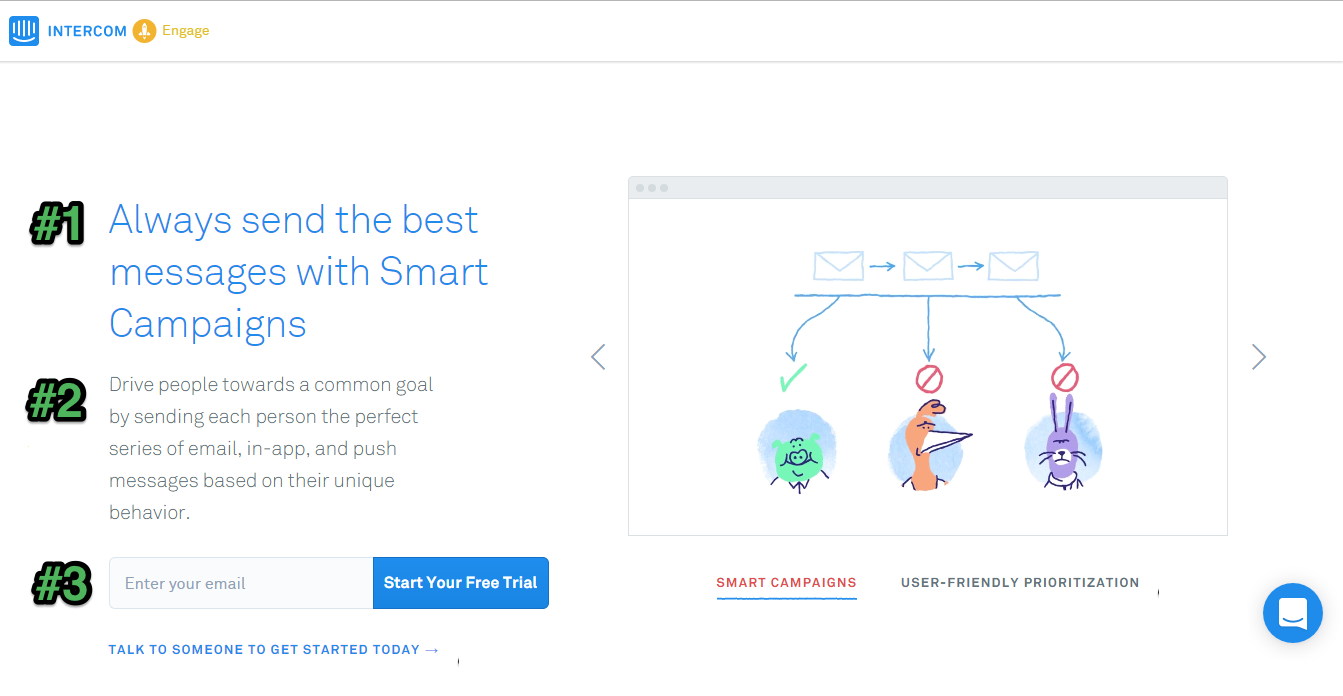
There’s a lot happening just on this one above-the-fold section, so let’s break it down with the first 3 parts:
1. The headline emphasizes the promise of something all businesses strive for (good communication)
2. The sub-headline gives some specifics as to the type of messages Intercom can help with (email, in-app and push messages) and hooks readers with the prospect of better sales conversions (“drive people towards a common goal by sending messages based on behaviour”)
3. Here’s an easy-to-spot and easy-to-use CTA which makes it hard to say “no”: You know it’s free and all you have to do is put in your email
And now onto 3 more parts of this above-the-fold section:
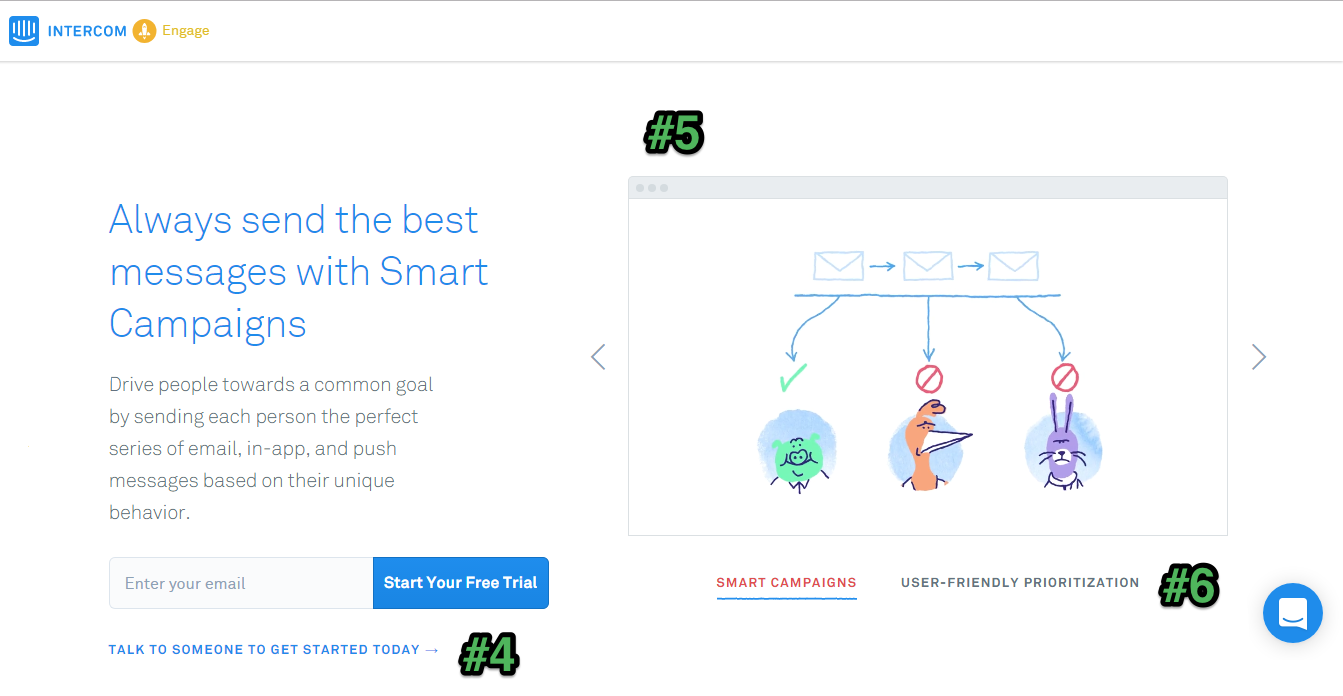
4. In case visitors want to know a bit more, they have a secondary CTA below the main CTA to speak to a representative via live chat (the same type of live chat that they, hypothetically, could add to their very own website should they choose to work with Intercom)
5. Visitors can watch a short, simplified animated explainer video that will give a visually appealing overview of how the product works and what customers can expect
6. Visitors also have the option to check out a second video that highlights the product working in action
If visitors want to know more, they can continue scrolling to read through the features in part #7.
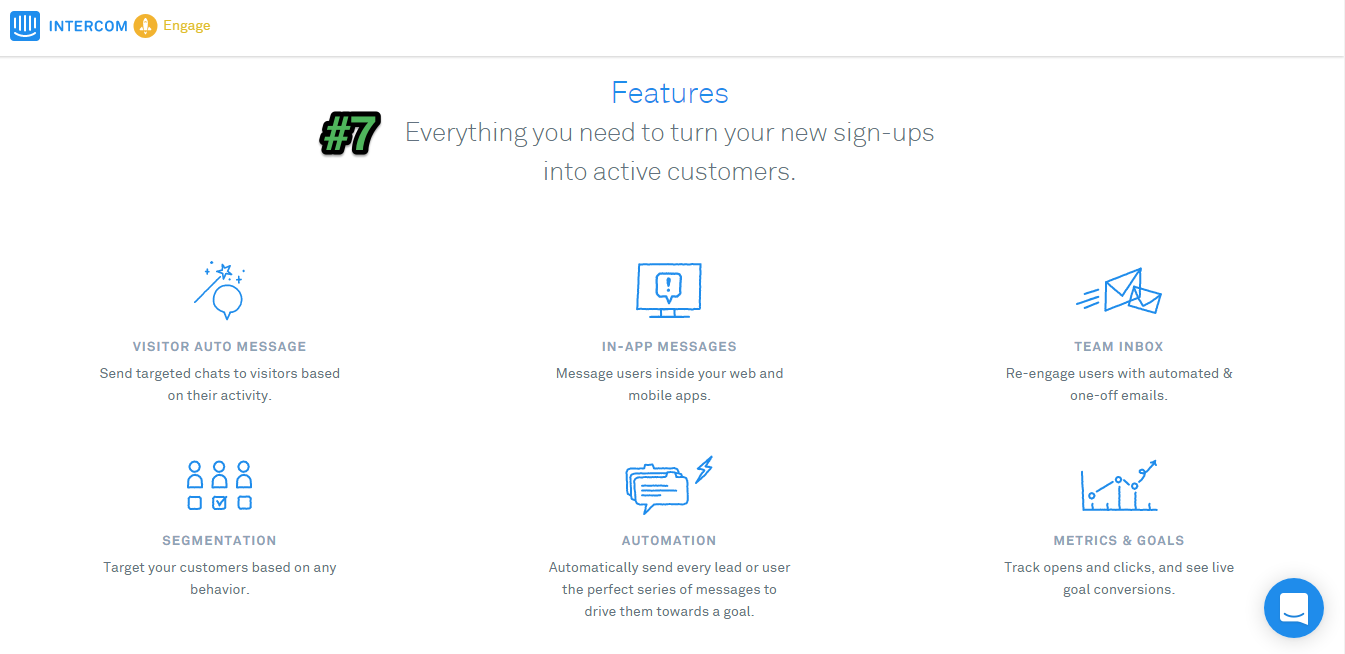
You may be thinking right now… why are they talking all about features and not benefits? Isn’t using benefit-driven copy marketing 101?
Well, yes and no.
Intercom understands people in their market already have a very high level of market awareness about products their solution is replacing. They’re what legendary copywriter Eugene Schwartz calls “Most Aware.”

When you’re marketing to customers in the “Most Aware” stage, you either need to differentiate yourself on product or price.
Intercom differentiates by telling people about their unique features. This lets potential buyers know how Intercom is different from standard marketing automation, CRM, live chat and help desk tools.
Intercom mentions some of the more surprising features that customers might not expect (for example, in-app messages).
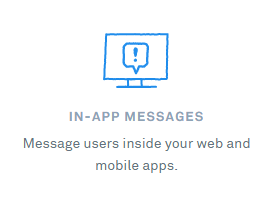
This section also uses catchy sales language that the visitors want to hear like “lead”, “drive them towards a goal,” “target your customers” and “live goal conversions.”
Once people know what Intercom’s Onboarding & Retention solution is and how it can help them, a final scroll offers some social proof and tells them what to do next:
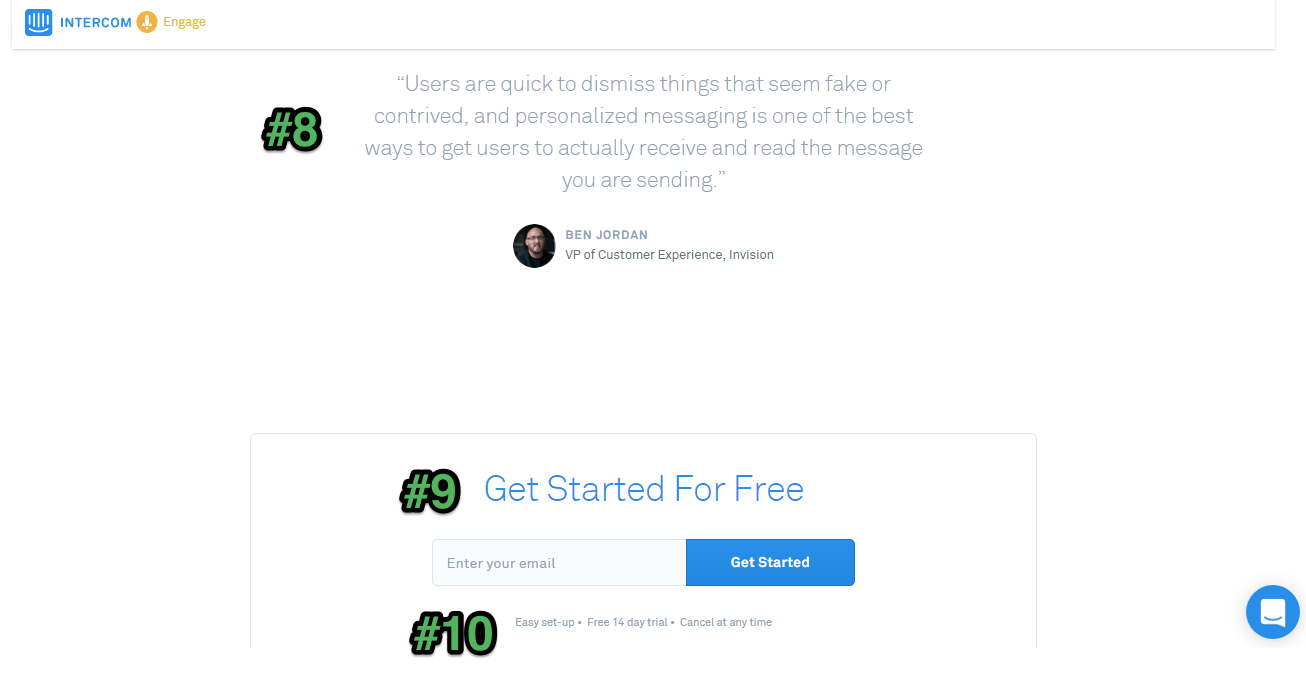
-
Personal testimonial from a VP at a big-name company. It’s been well-established that headshots with short testimonials near CTA buttons and lead forms promote increased conversions
-
Final CTA that’s clear and easy-to-follow
-
Fine print under the email field tackles any last-minute doubts visitors have… making it highly likely that they will at least succumb to testing out the free 14-day trial.
All three of Intercom’s solutions have a very similar landing page layout by covering the very same sections numbered 1-10.
The takeaway: Match your landing page copy with the level of market awareness for your product in your market to convert more of your traffic into customers (Intercom do it by telling people in the “Most Aware” level of market awareness about their unique features to differentiate themselves from ordinary live chat, onboarding and messaging software).
[Tip #9] The “Starter Kit” Lead Gen Offer That Will Make Your Website Visitors Dribble All Over Their Keyboards
Most customers are sick of having to give their emails for everything. eBooks, bonus PDFs, free video courses – you name it, and you probably give have to give your email to get it.
Which means if you actually want to gather lead contact info, you have to create something so enticing and valuable that prospects won’t just roll their eyes and “X” out of your page as soon as they see an “enter your email” field.
Intercom has done this by creating 3 “starter kits” that revolve around topics their audience are definitely interested in: onboarding, nurturing and messaging.

The starter kits are in-depth, well-organized guides that are useful for nearly any business (seriously, what business isn’t interested in nurturing or improving their messaging?).
Of course, it’s not just enough to create a lead gen that people actually want to give their emails for – you have to find a way to promote it to capture the most amount of emails possible.
Intercom does this by sharing on their social media networks and through their Medium publication.
Here are some of their Twitter posts about it:
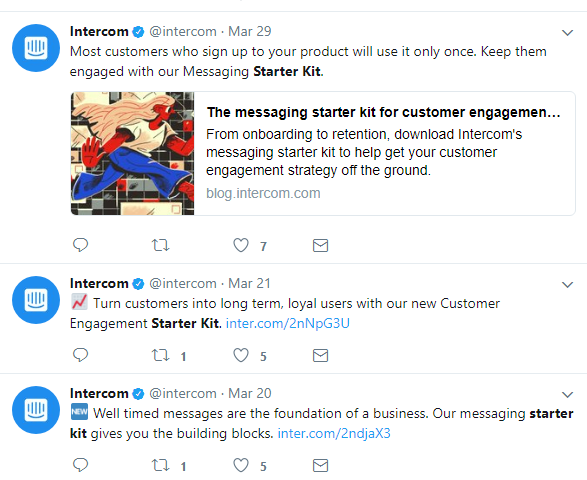
Tweets have short lifespans, so Intercom don’t just post one time and be done with it…they post several times over a week and then repost it again every few weeks with a different angle.
Intercom are also experimenting with different messaging (problem-based vs desire-based and image vs no image). Here is a tweet where they promoted a new starter kit using an image:
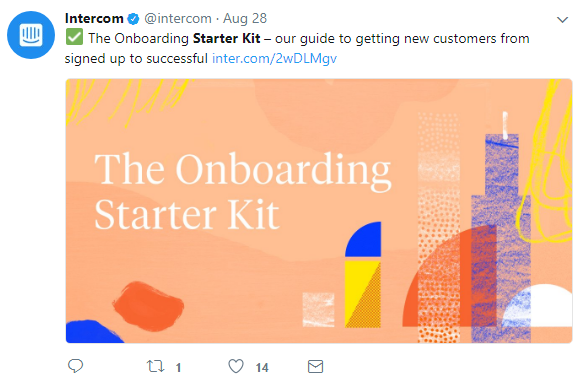
Golden Nugget: Take note of how Intercom are using an “inter.com” branded short domain in their Tweets. This is a tactic Intercom are using to track how many clicks each of their different tweets get.
Click here to reveal the branded short domain tool Intercom uses.
Intercom also promote the starter kits on their Medium publication with 3 different types of articles.
Article Type #1: The Overtly Promotional
From the title alone, Intercom makes it obvious that this article is promoting the starter kit and the entire article breaks down what you’ll learn from it.
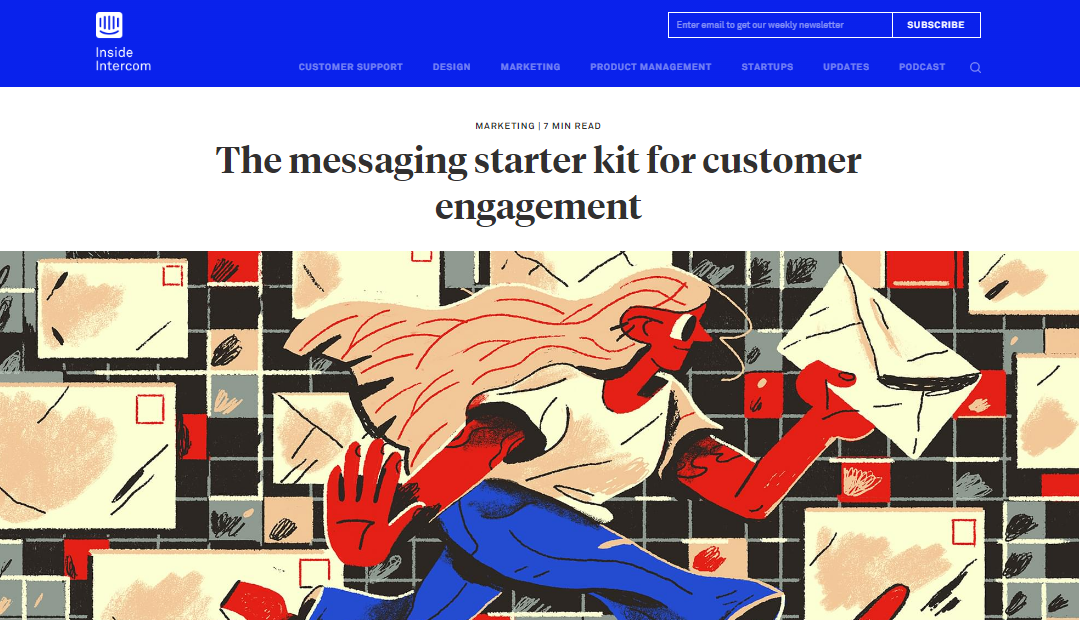
This breakdown is followed by a direct CTA:
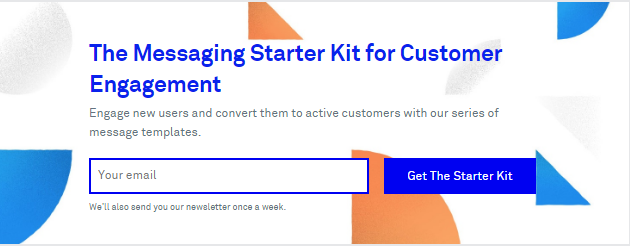
Article Type #2: The Covertly Promotional
The title of this article doesn’t make it obvious that the article is promoting the starter kit (it just sounds like a typical how-to style blog post about onboarding):

But the body of the article quickly transitions into a promotional angle by opening up with pain-based copy and then offering The Onboarding Starter Kit as a content upgrade:

The rest of the article gives some screenshots of what people will find inside the starter kit:
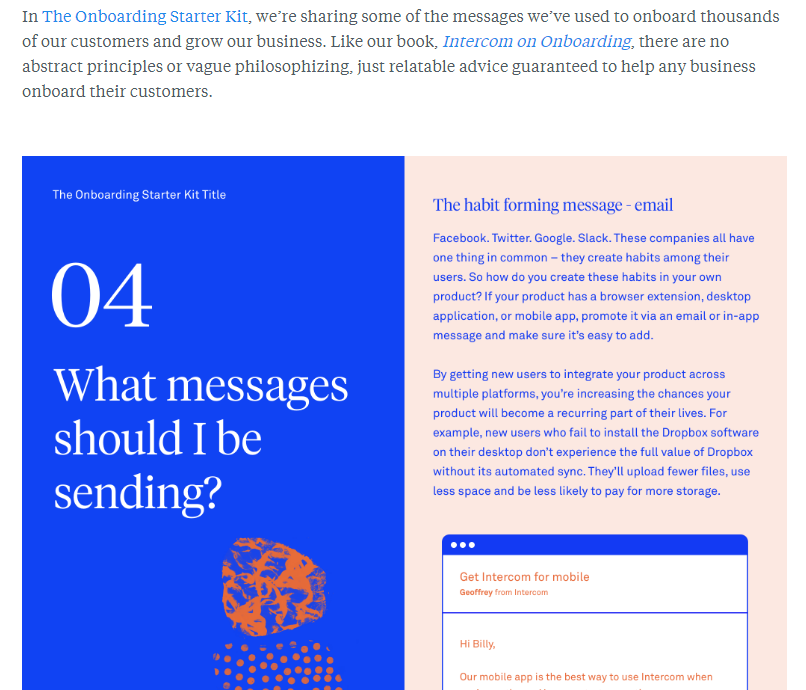
And closes with a CTA asking people to take a look:

This particular article actually directs people straight to the starter kit (without asking for their email), but you could consider making this gated for your own business.
Article Type #3: The Info-Based Non-Promotional
The final type of article isn’t actually promotional at all – you won’t find any mention of the starter kit until the very final CTA.
But it is still a great way to attract the right audience. As you can see by the title, this will grab the attention of the exact type of people who will be interested in the starter kit (as both the starter kit as well as the article are about messaging):
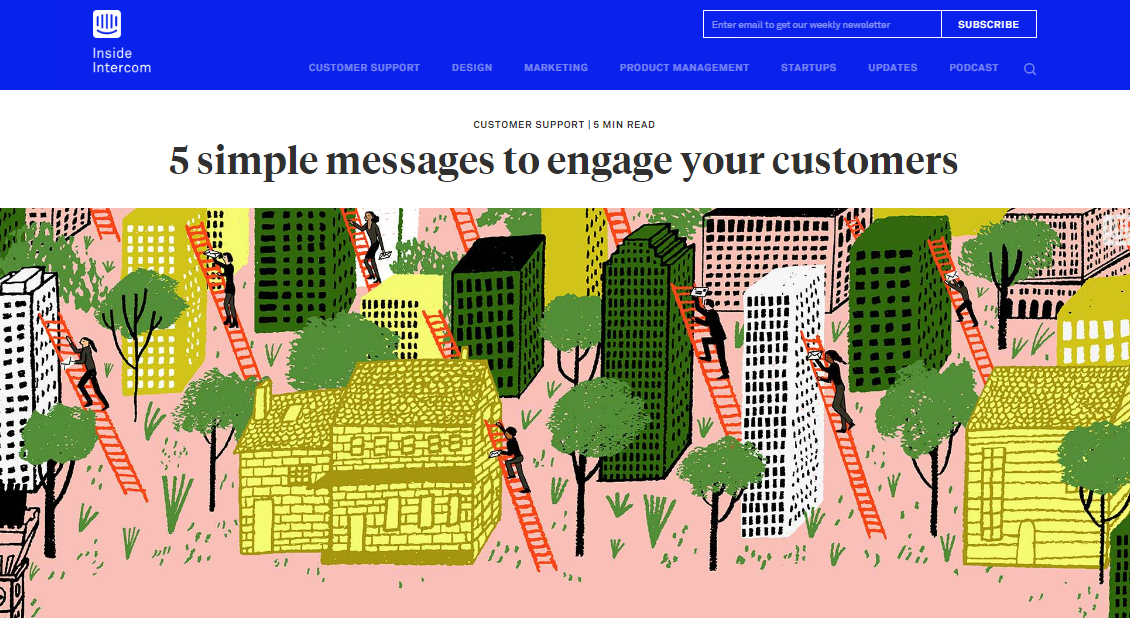
The article then continues as a purely information, tip-based article that gives prospects value.
But at the end, the final CTA invites prospects to continue their messaging “research” by opting in for the complete messaging starter kit:

The takeaway: Find what your prospects are interested in, then create and promote a super enticing lead gen offer that they can’t say “no” to (Intercom do it by creating Starter Kits and promoting them across their Twitter, Medium and Blog).
[Tip #10] Use The JTBD Framework To Create A Hockey Stick Growth Go-To-Market Strategy
Jobs-To-Be-Done (JTBD) is the framework Intercom used to inform their entire go-to-market strategy and 5X their qualified traffic from 35k/mo uniques to 220k/mo uniques in 1.5 years at the start of their business.
JTBD is based on this principle: customers come from a variety of backgrounds, industries and verticals, but their one commonality is their motivation, the Job-to-be-Done.
Here is what a traditional persona-based marketing profile looks like:
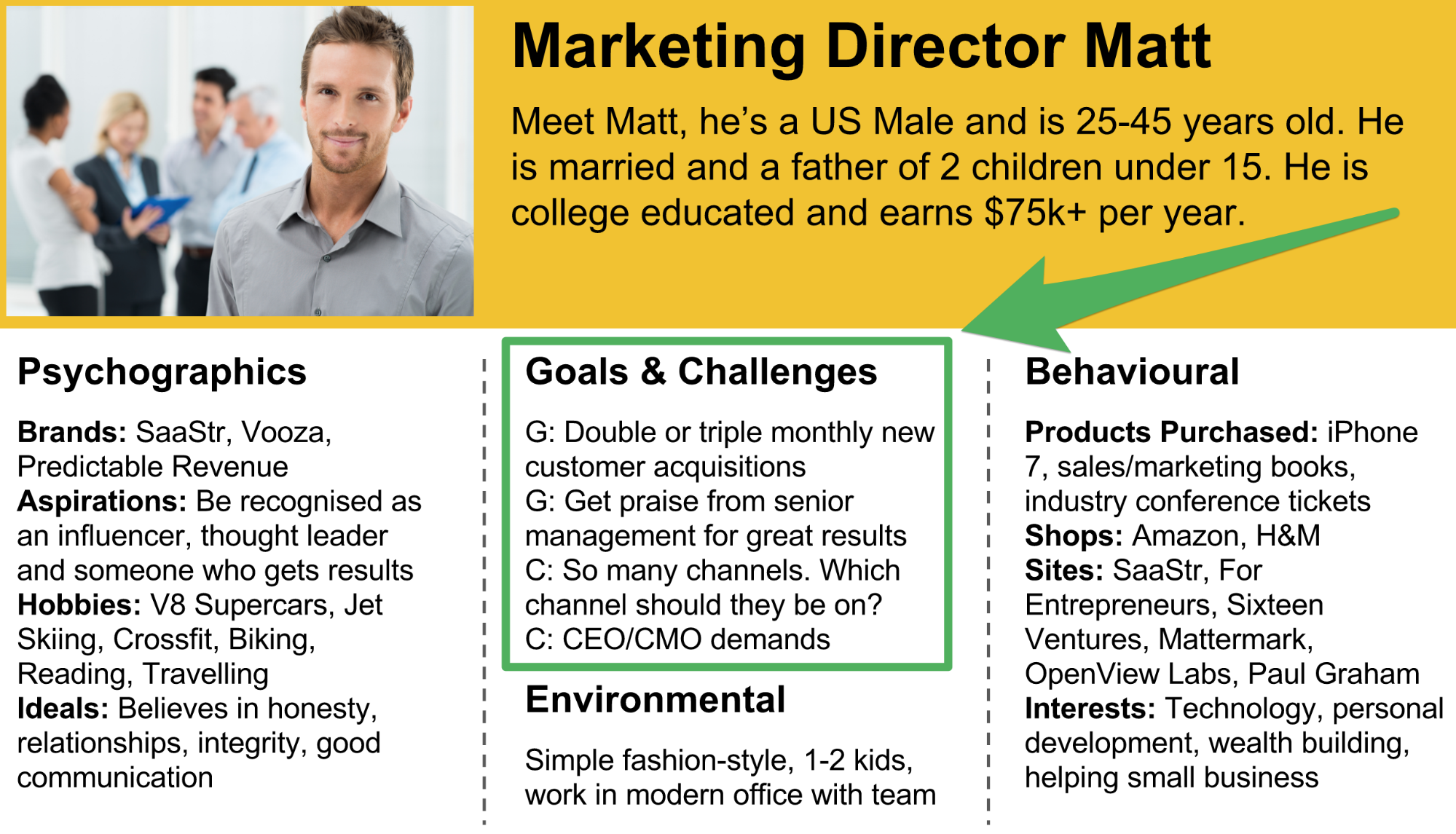
Rather than focusing on customer attributes, with JTBD you focus on what your customers actually need. In the persona-based example above, the Jobs-To-Be-Done of the customer are:
- I want to get more customers
- I want to impress senior management
- I want to know which marketing channel to invest in
- I want to make my boss happy
Intercom feels so strongly about the methodology and it’s worked so well for them that they’ve created an entire free eBook about it.[*]
They also have numerous blog posts and talks about it (like the one below by Matt Hodges, Intercom’s Senior Director of Product Marketing).[*]
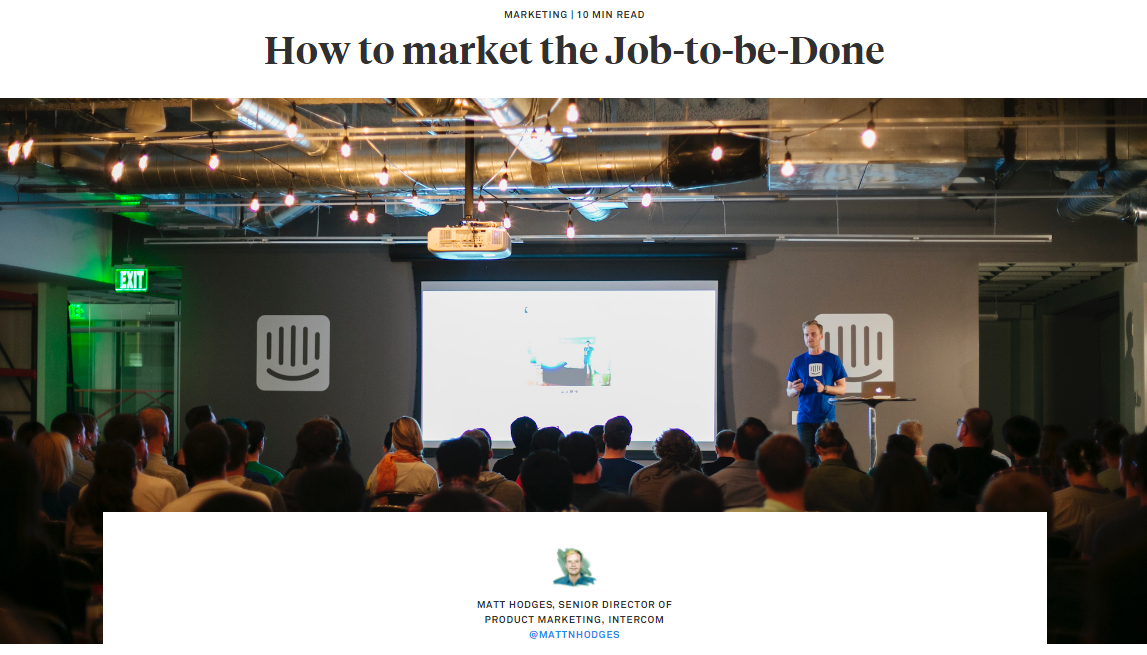
The JTBD methodology begins with one big question that becomes the basis for all you do:

Beginning with this question lets you work from the ground up and makes sure you do the right customer legwork and research so the rest of your marketing tactics (like the tips I give you below) are successful.
So, how do you begin answering this question and understanding what the Job-To-Be-Done is?
As Matt describes, it all comes down to lots and lots of talking:
“You need to talk to lots of different people. You need to talk to a broad spectrum of your customers – brand-new customers, people who just signed up, people that cancelled last week, people that have been users for a long time, etc.”
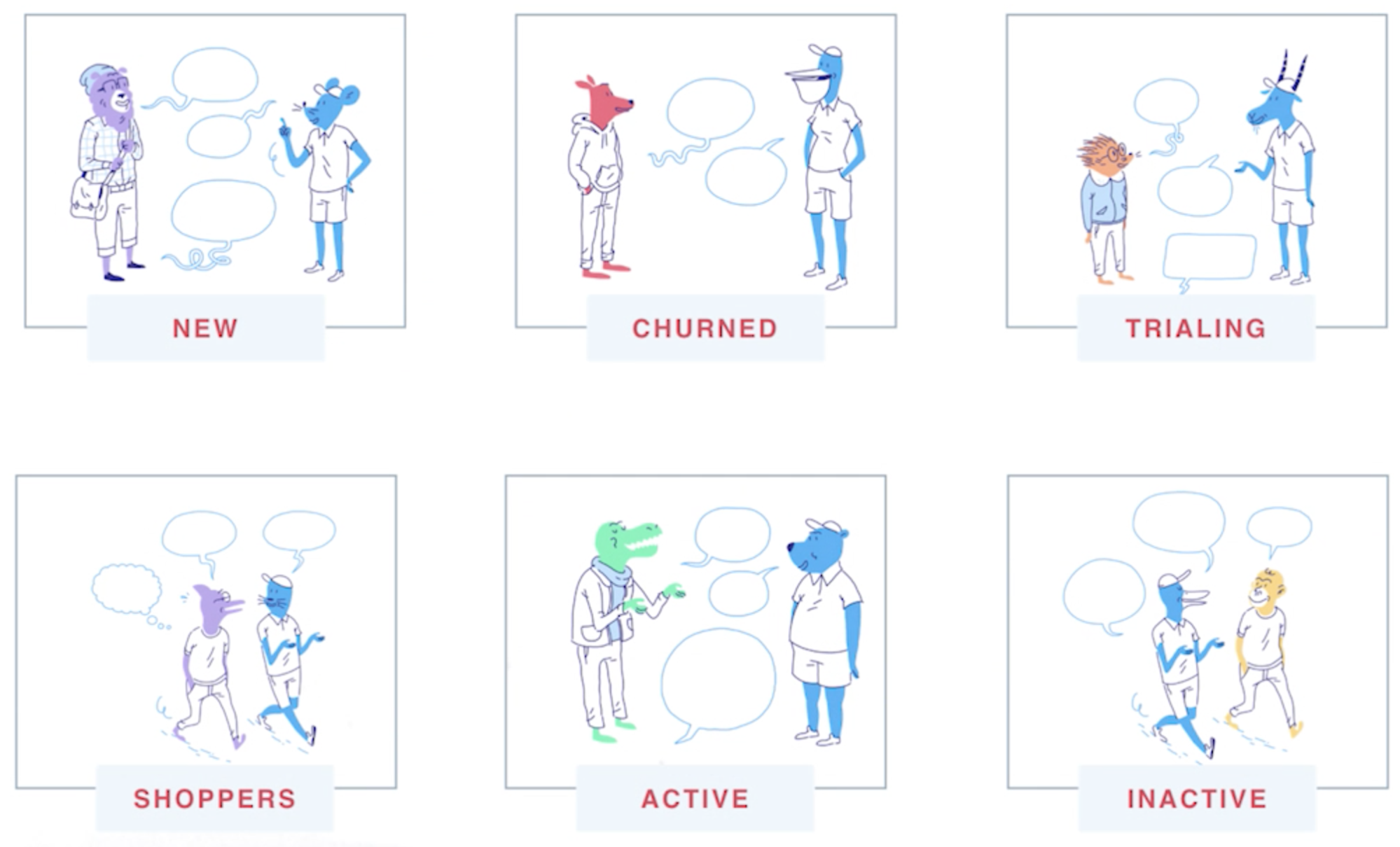
Intercom did this by working with a consultancy based in Detroit that specialize in the jobs-to-be-done methodology.
Click here to reveal the JTBD consultancy Intercom hired.
They helped Intercom conduct 45 phone interviews with customers. Then, Intercom went to the consultancy office in Detroit to study 15 of those conversations in detail over two days.

After talking to their customers and finding out what jobs they actually needed done, Intercom ended up taking their initial single product that they marketed to 4 different customer personas (which was getting them monthly unique traffic of roughly 35,000 website visitors):
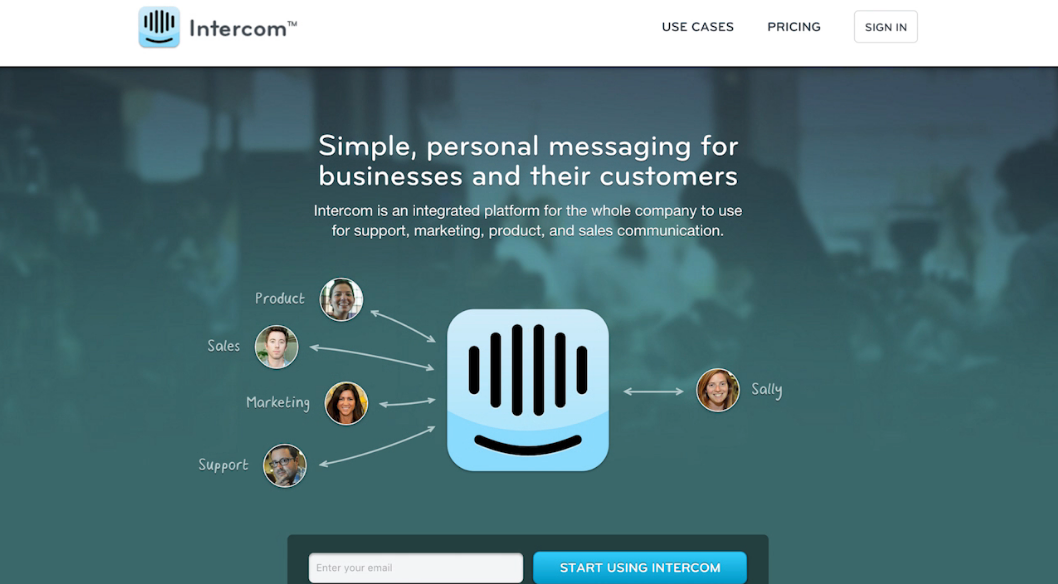

And transitioned to a 4 product model, with each product designed to do one of the jobs Intercom chose based on their deep study of the 15 phone interviews with customers:
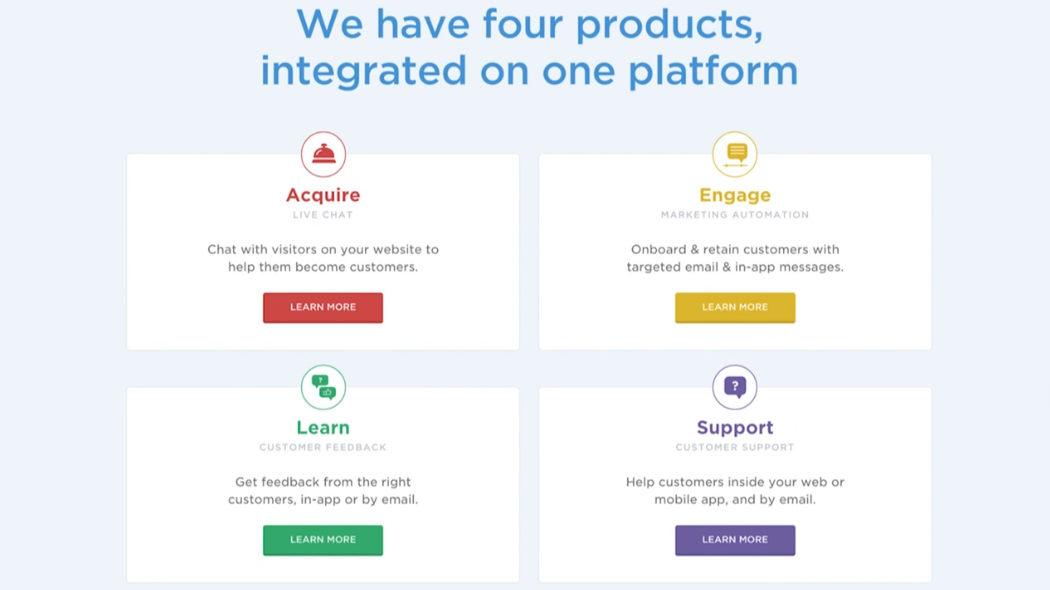
While this transition wasn’t a fundamental shift in Intercom’s vision, it was a fundamental shift in their go-to-market strategy. The focus was less on “what you want to sell,” and more on “what your customers actually need.”
Once you have these jobs established, your new goal with marketing should then be to “take those jobs and clearly articulate the problems they solve.”
As an example, Intercom has a landing page for their Engage product which “helps you understand the problem and then goes deep into how the product works and how you can use it”:
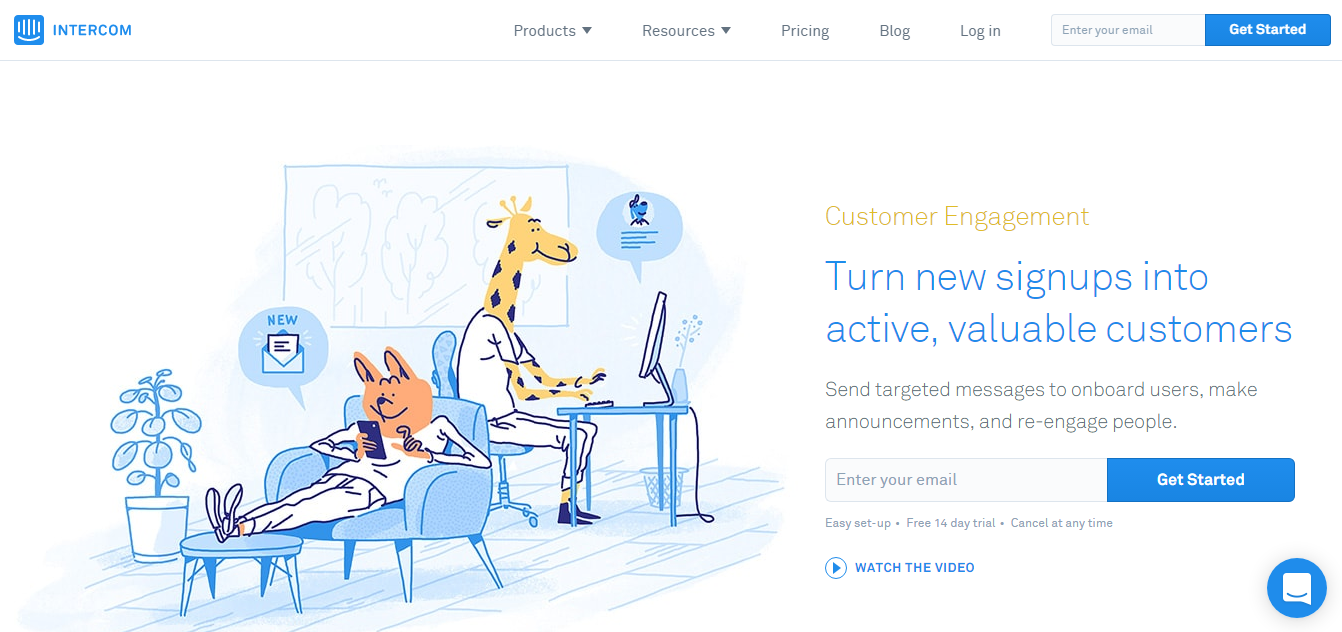
And the results are hard to argue with, as this methodology and product marketing transition were part of what helped Intercom pave the way for their nearly 5X traffic growth:

Once you’ve established your customer’s jobs-to-be-done, you can take it several steps further as the methodology lets you “be so much more strategic about identifying the different channels, mediums, and tactics you want to use to reach your audience.”
For Matt, this started by asking “who are the people who would want to hire Intercom for one of these four jobs?” (You can try out that question for you own company by subbing in your company’s name and the # of jobs you do.)

As it turns out, there were a lot of companies who wanted to hire Intercom for one of those four jobs.
Once you answer that, you need to follow the steps Intercom take to market their products:
Step 1: Reach
To reach the right audience, Intercom sponsors tradeshows and events where they know they’ll meet the people who could hire Intercom for the jobs-to-be-done in their business.
As an example, Intercom have a booth at Mind the Project every year – a project management conference – in London. This is a perfect audience for their products.
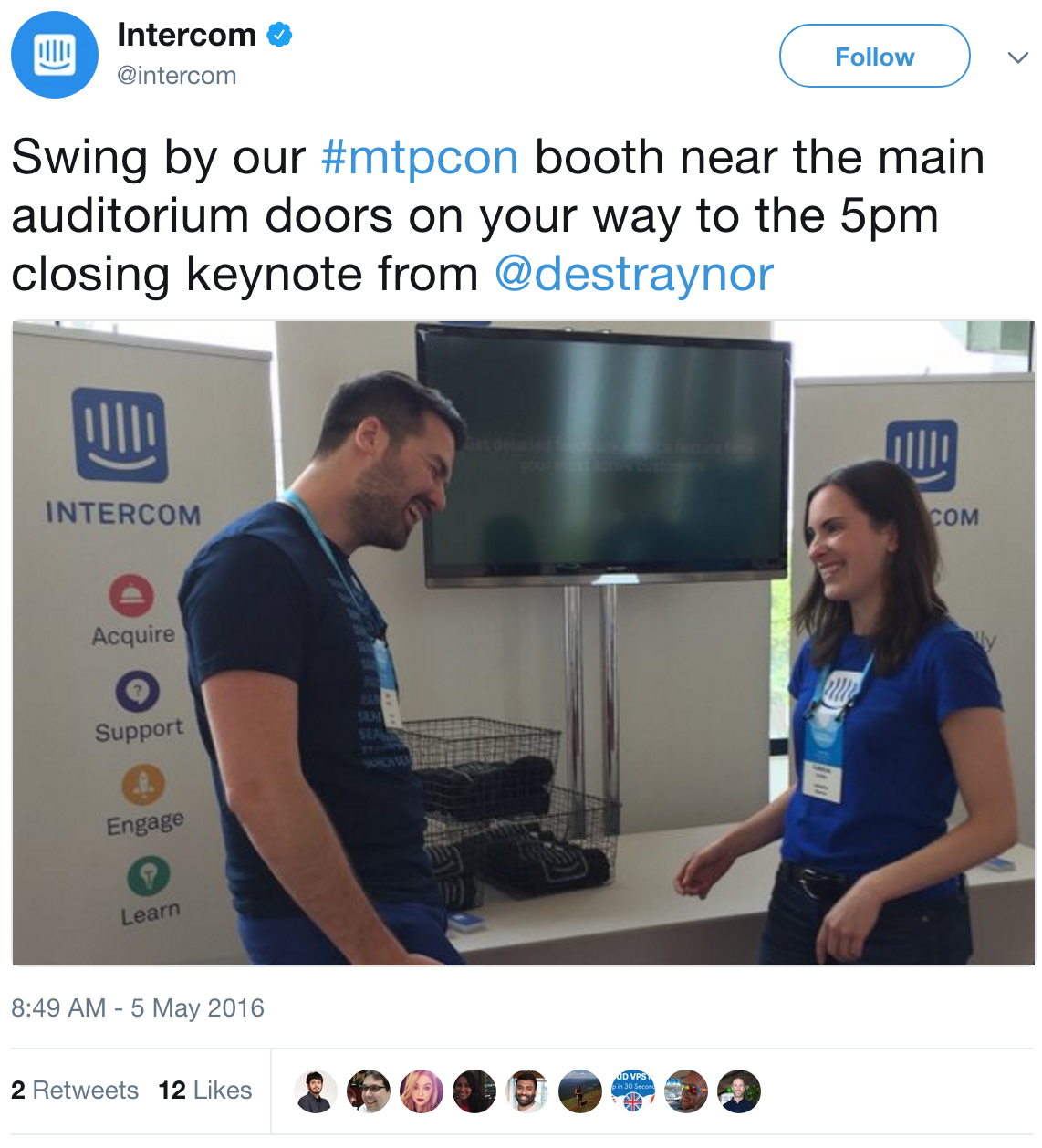
Intercom also makes an effort to speak at events like this (Intercom co-founder Des Traynor speaks at Mind the Project) to extend their reach even more.
Step 2: Attract
Intercom invest a lot of time and effort into producing content that attracts people to the brand. This content comes in the form of:
- Blog posts (where all company departments contribute: engineering, marketing, sales, finance and product)[*]
- Books[*]
- Landing pages focused on helping people make better product decisions (like this one down below).[*]

Step 3: Convince
After they’ve attracted and introduced people to Intercom, they then need to convince those people to hire Intercom for their job. They do this with their product landing pages (you will read about those later in Tip #9).
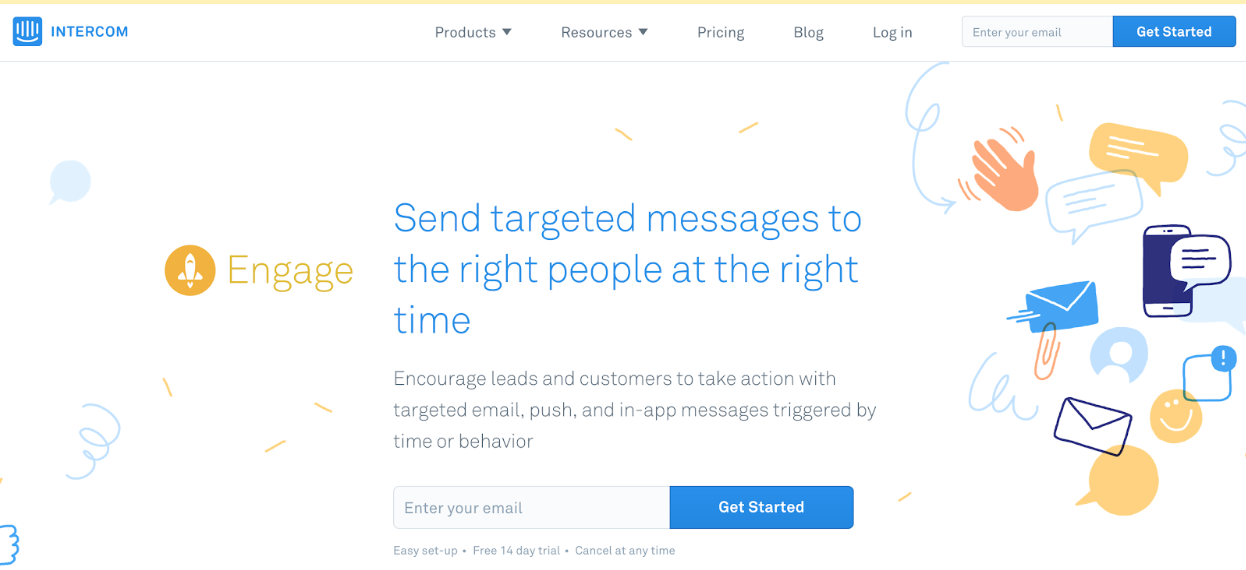
Step 4: Educate
Once people are in the product, Intercom has to make sure people get the full value by educating them on using the product. They do this with timely, targeted in-app messages that help you use Intercom for your job.
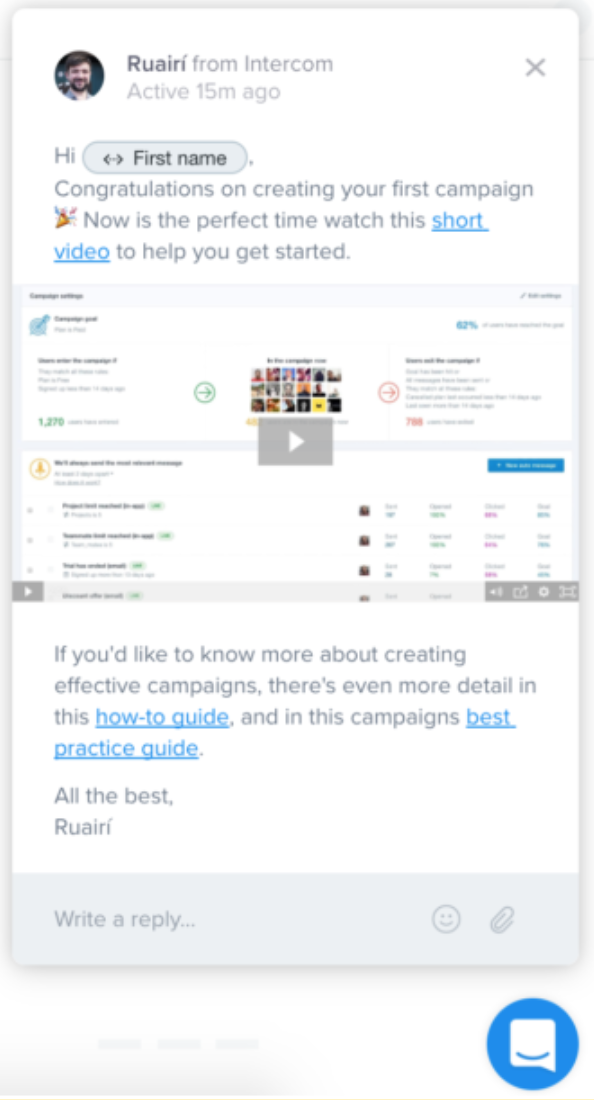
They also combine this with a help center.[*]
And weekly product demos.[*]

Both of these are structured around Intercom’s specific jobs.
Step 5: Delight
The final step is to make sure you have happy customers. Intercom do this by continually shipping new features and additions to their products which are all focused on helping their customers do the jobs better.
You can use the Jobs-To-Be-Done framework to improve your business and “continually delight” customers in smaller ways, too.
Here’s an example of how you can make your customers happier by marketing the job-to-be-done for individual features of your product.
When Intercom first set up their User Map feature (which gives a live view of where your customers are around the world), they “thought of it as just that. [They] thought of it as a map.”

But after a bit more sleuthing, they realized that the map’s “job” was more than just being a map. They found instead that people were using the map to impress investors, impress people on Twitter and impress people at expos.

Without realizing the map’s true job, Intercom would have just focused on improving the map based on all the typical features a map would be expected to have.
But once Intercom understood the map’s job, they took it another direction and built a map that was “live, animated, and shareable.” AKA exactly what someone who’s using the map to fulfill the job of showing off would want.
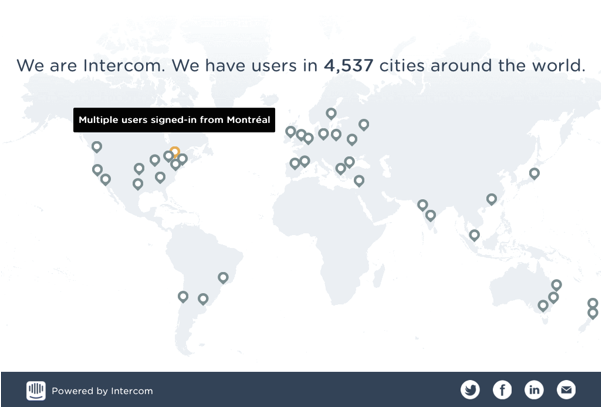
It’s seems like an easy enough fix, but it’s one that made Intercom a LOT of happy customers and gave customers a reason to broadcast Intercom’s brand throughout social media:[*]
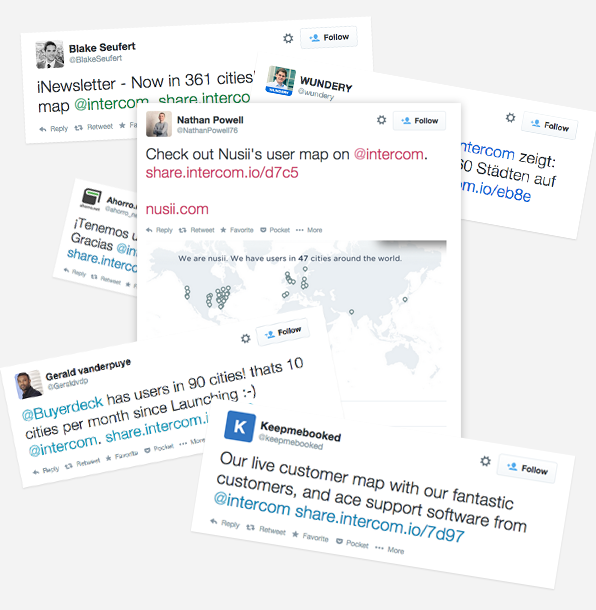
The takeaway: Use the Jobs-To-Be-Done methodology to figure out what job people are hiring your product for. Then use it to structure your entire marketing strategy (Intercom did it by getting help from a JTBD consultancy who interviewed their customers. They then went through the data and changed their go-to-market strategy to marketing 4 products that solve different jobs vs marketing 1 product to 4 different customer personas).
10 Key Takeaways From Intercom’s $50 Million Dollar Success
Intercom has adopted marketing strategies outside of the norm, and that’s how they separate themselves and stay wildly successful.
By avoiding flashy CTAs and big, over-the-top sales promises, Intercom has kept its core ideas strong.
In other words, it remains a company that thrives on word-of-mouth brand awareness by creating content that’s useful to its customers and true to its company’s vision of personal communication.
Of course, this isn’t to say their entire strategy is perfect – but you’ve seen the results possible after just 6 years, and you’ve seen the analysis.
Here are the key takeaways:
- Identify marketing channels that are already working for you right now and look for ways to growth hack them to a whole new level (like Intercom did with their referral traffic by combining the “powered by” tactic with dynamic keyword insertion).
- If you want to steal your competitors traffic, use “Alternative” landing pages that clearly outline the unique selling points your product has vs your competitor.
- SEO can be simple if you just focus on “core problems” instead of keywords. It will ultimately lead to better rankings and help you generate more qualified leads.
- Remember that you’re building a brand. Consistently create quality branded content based on proven topics (which you can find by using the 5 content tactics from Intercom’s “Proven Topic Framework”).
- Think about what the most logical next step is for someone to take after reading your content piece and use that as your CTA. Is it to download your book, download a cheat sheet, sign-up for your newsletter or something else?
- Look for other media platforms where your target audience hang out and re-purpose your content for that platform (like Intercom are doing with their blog content on Medium).
- PPC traffic works best when you go ultra-granular (1 Keyword > 1 Ad > 1 Landing Page). It’s a strategy I see more and more SaaS companies like Intercom using to increase qualified leads as they dial in their PPC campaigns.
- Match your landing page copy with the level of market awareness for your product in your market to convert more of your traffic into customers.
- People are sick of giving their emails for everything, so you need to make sure your lead gen offer is value-packed and enticing. Then, promote, promote, promote.
- Put the Jobs-To-Be-Done Methodology at the core of your marketing strategy.
- Eat more tacos, it will make you healthy, wealthy and wise like Noah 😉
The first version of this growth study was originally published on OkDork
Related Articles
%(relatedarticles)
Add A Comment
VIEW THE COMMENTS